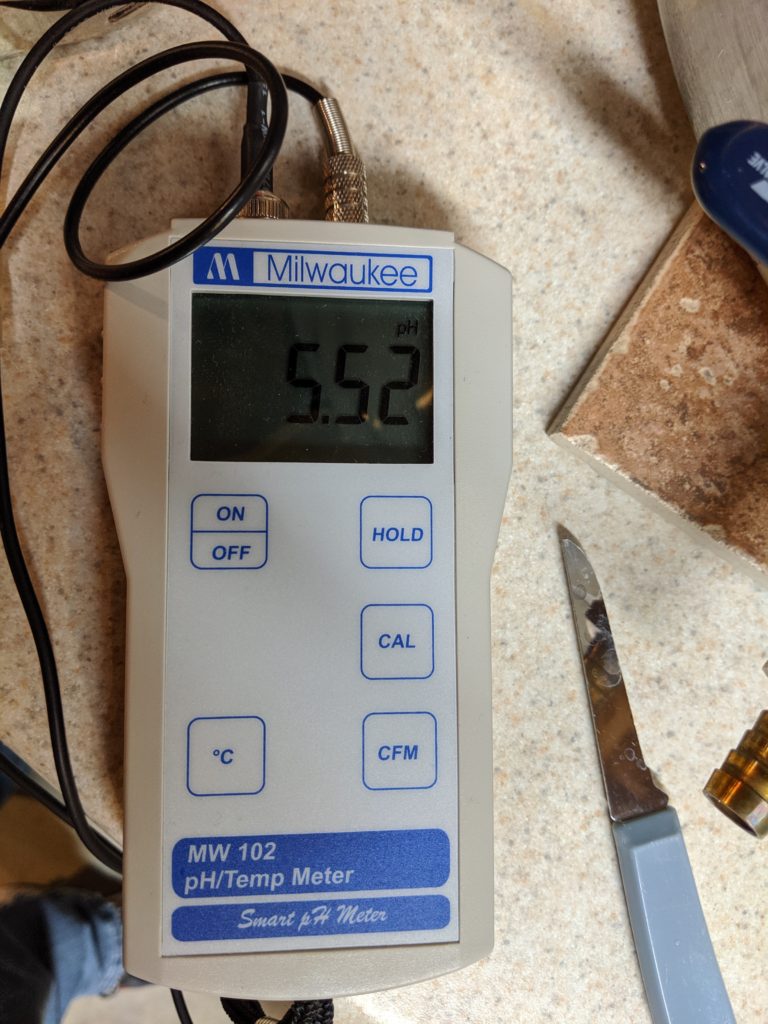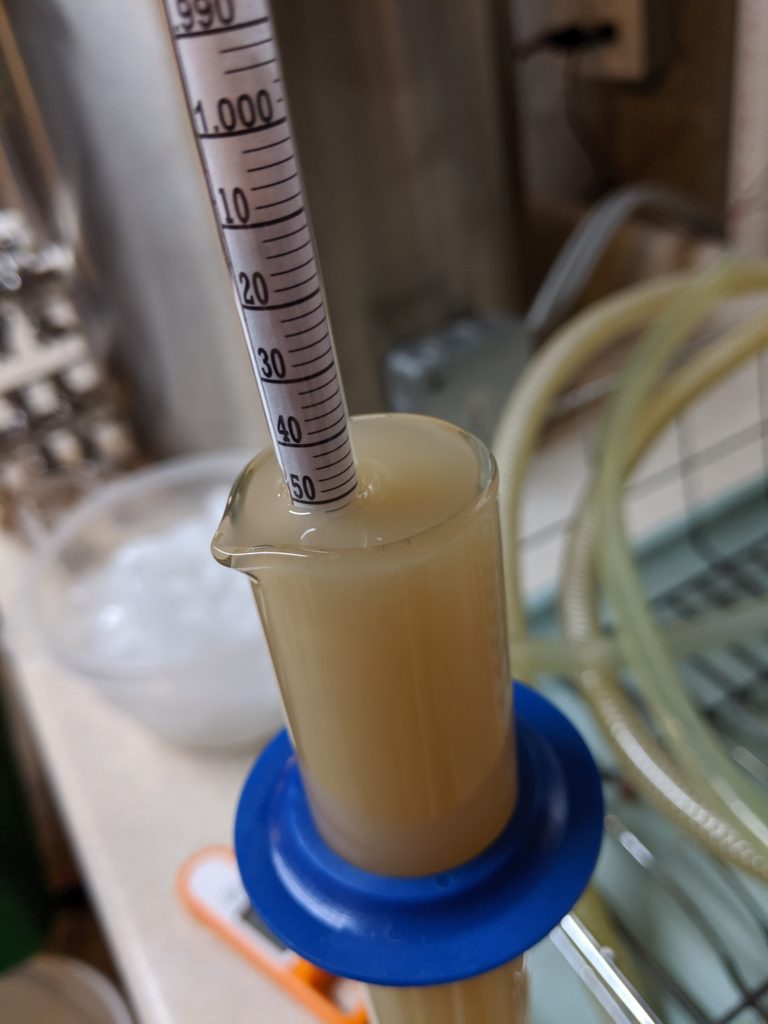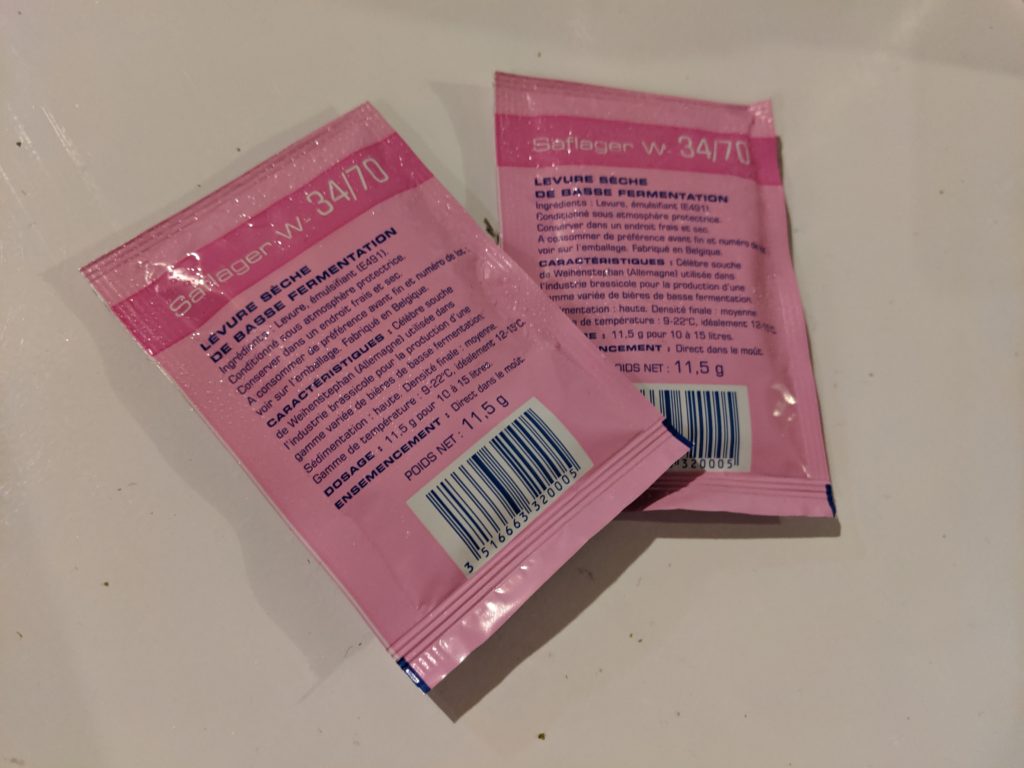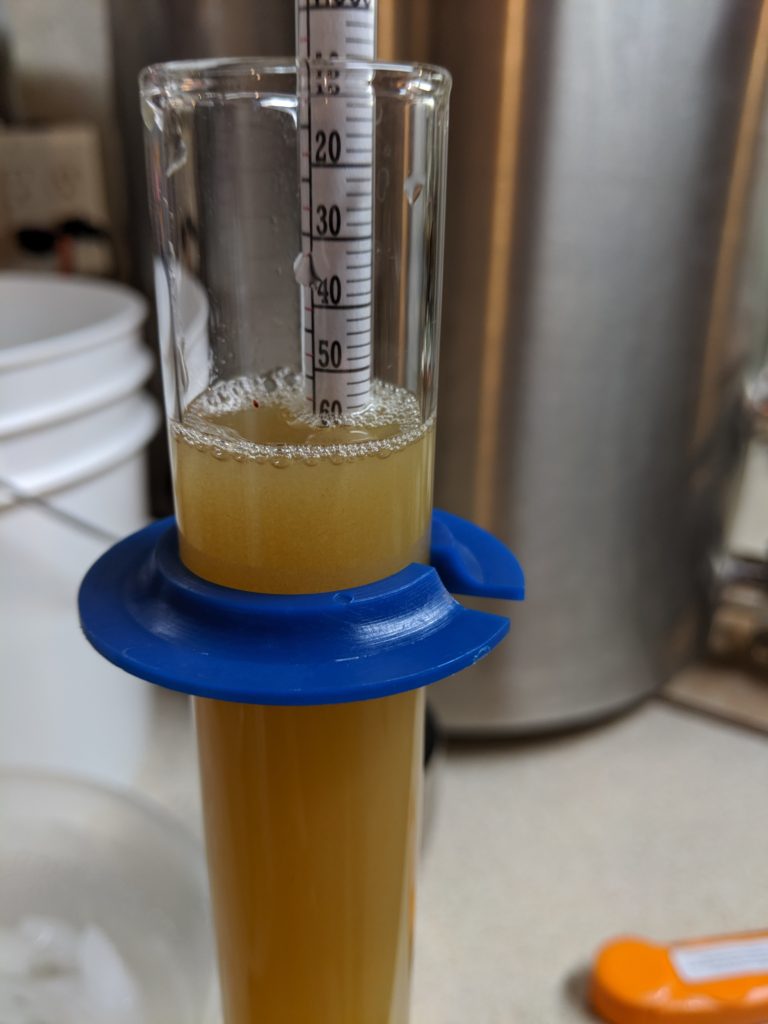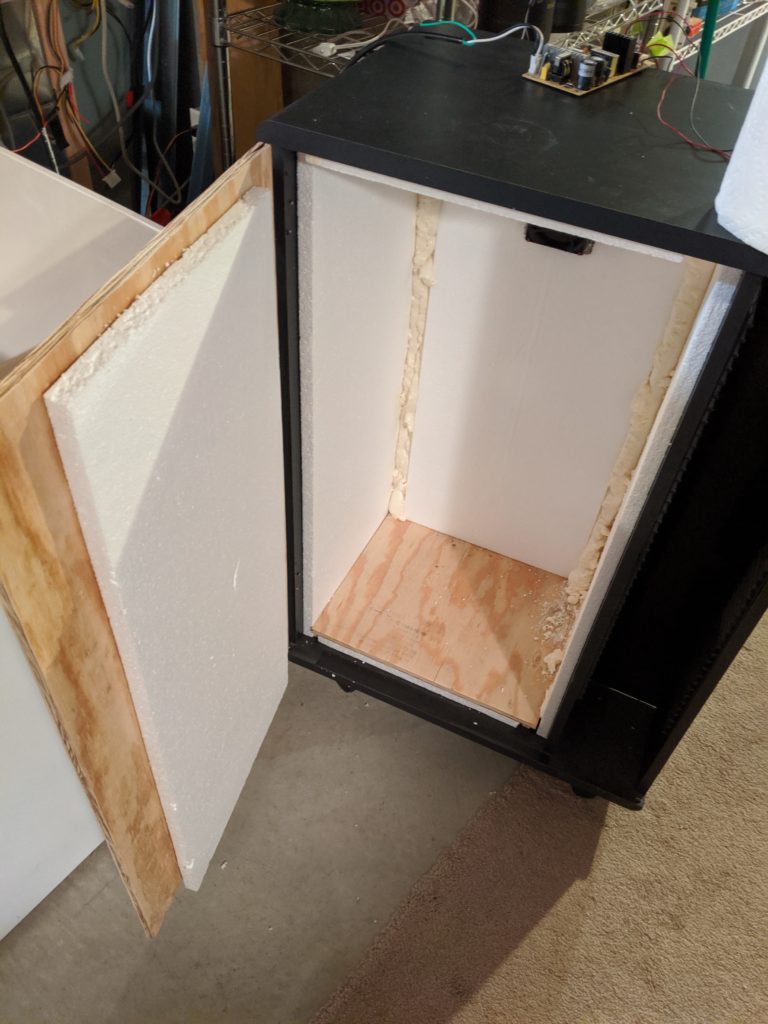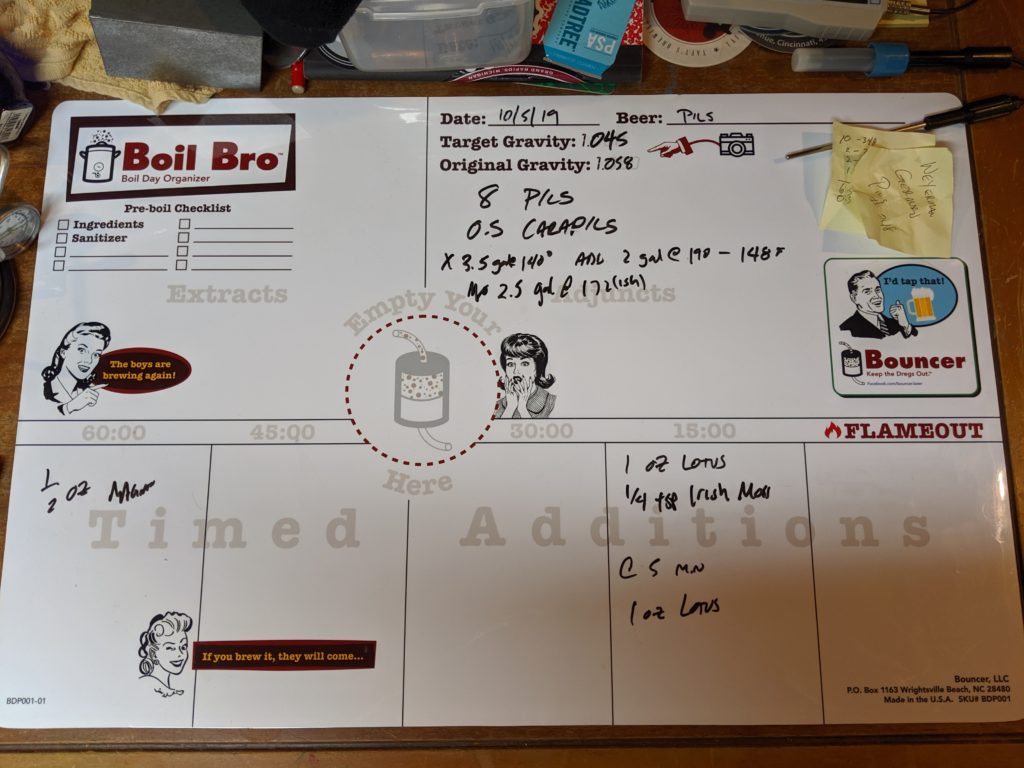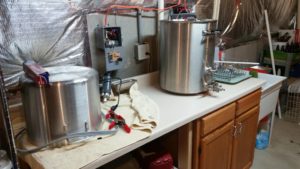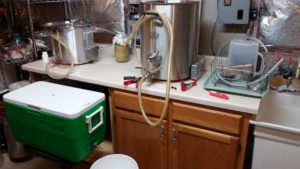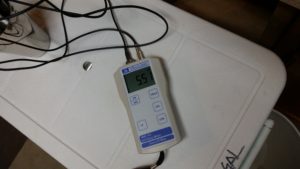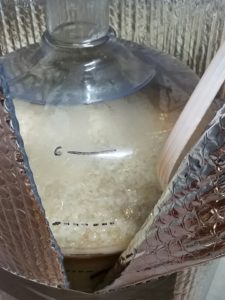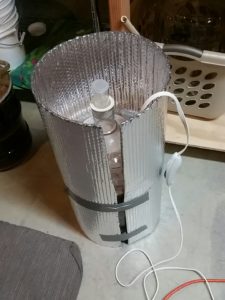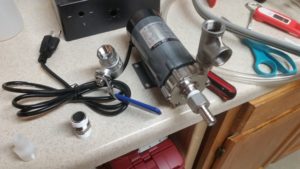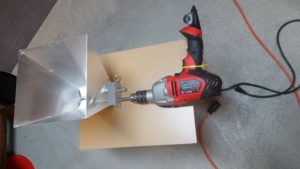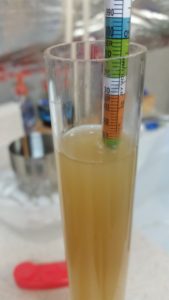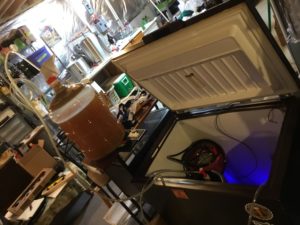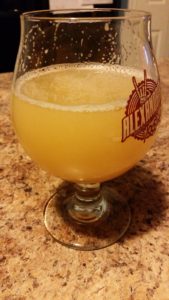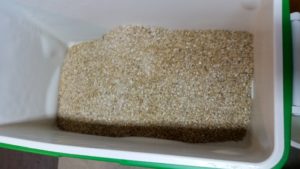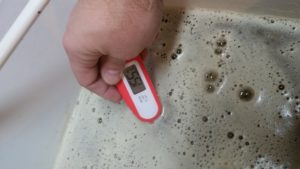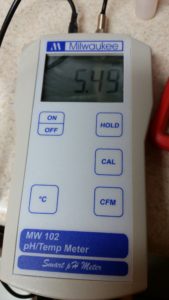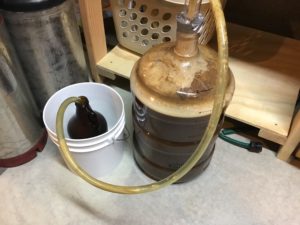Author Archive: Andrew
Hey, Let’s Make a Lager!
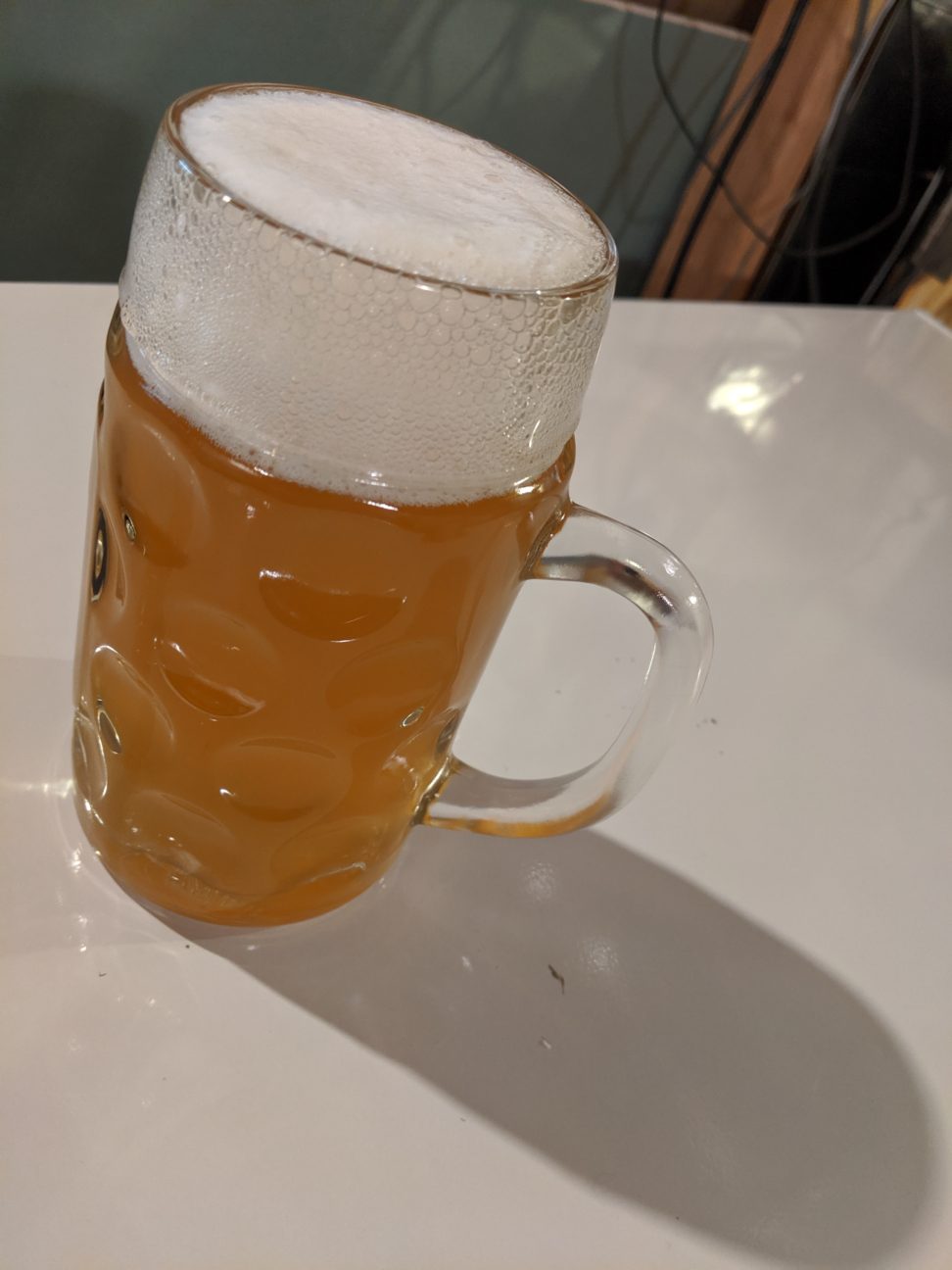
A few weeks ago, I recieved some sample hops courtesy of Exit 12 Brewery, and wanted to make something light-ish that I could drink while watching football.
I didn’t have a specific plan in mind, so I looked back at a previous brew I did, Vampire Dust. Initially, I thought it was a lager, but maybe not (I certainly didn’t lager with London Ale yeast!).
The recipe turned out as below. I was concerned with the bitterness of the beer, but we all know The IBU Is A Lie. I think it’ll be fine.
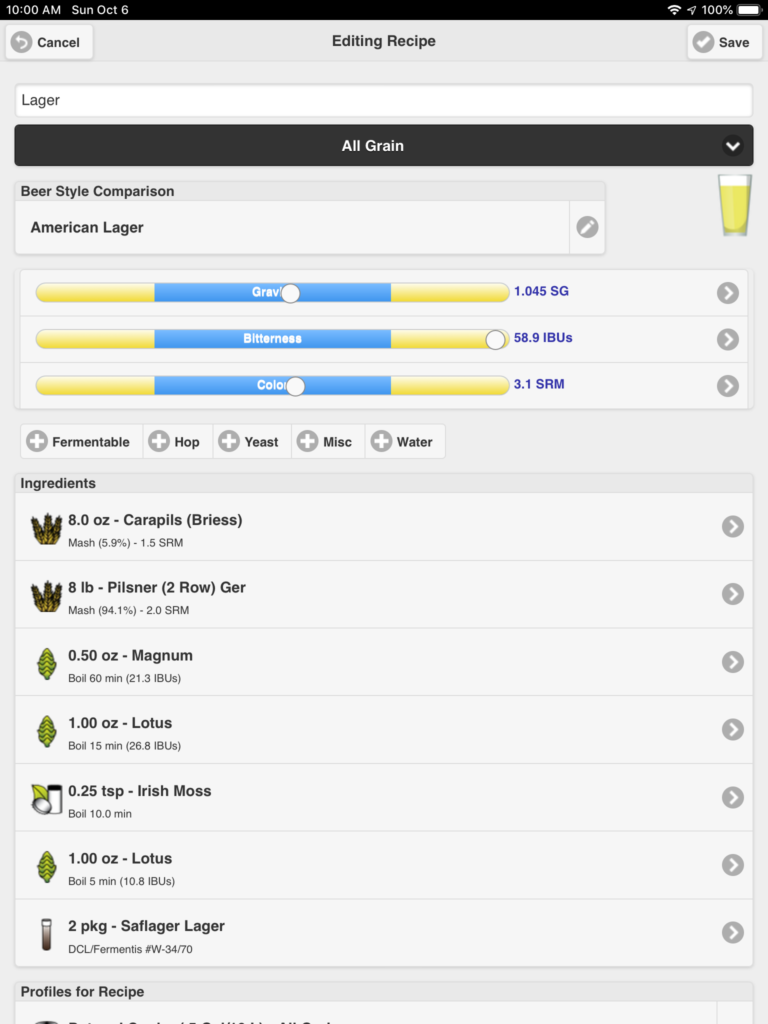
I had water set out from the night before and got started, but I saw some soapy-looking foam on the top of the first batch. Despite not tasting soap, I didn’t trust it. I dumped it and heated up my second batch of water. Ultimately, some sparge water came from the tap and was treated with Campden.
I mashed in without checking my HLT temp and found my mash temp to be down to about 140F, which is much lower than normal. So I heated up more water (which was going to be my sparge water) and added 2 gallons of 172-ish degree water to get the mash temp just up to 148F. I let it go for an hour and pulled a sample at the end to check gravity and pH. Gravity was 1.052 and pH was 5.5.
Boiled for 60 minutes with no issues, adding hops as scheduled above. Pulled a sample of wort at the end of the boil and began chilling and filling the carboy, which ultimately went into my keezer to chill more since groundwater is still a bit warm.
Went to check the OG… 1.056. This entirely baffles me, since I’m never that efficient. It’s making me question my thermometer. Presuming this beer finishes around 1.010, I’m going to end up with close to a 6% lager. Even more so, I’m going to check my thermometer. In addition, I may have mis-measured grain (or paid for an extra half pound). I checked the recipe with an extra half pound of pilsner malt and it bumps the 1.045 OG up to 1.048.
I decided that since W-34/70 tends to work well at room temperature, I’ll try my fermentation chamber that I’ve been building. I quickly added some styrofoam insulation to the top and door and got the peltier element running. Thinking that I might have to deal with issues of it staying a little warm, I didn’t add a temperature probe yet. I chilled the fermenter to 55F and move it to the chamber.
I learned that it isn’t working all that well. After seeing the temperature rise into the 60s F, I added some fans to try to help the situation. It didn’t.
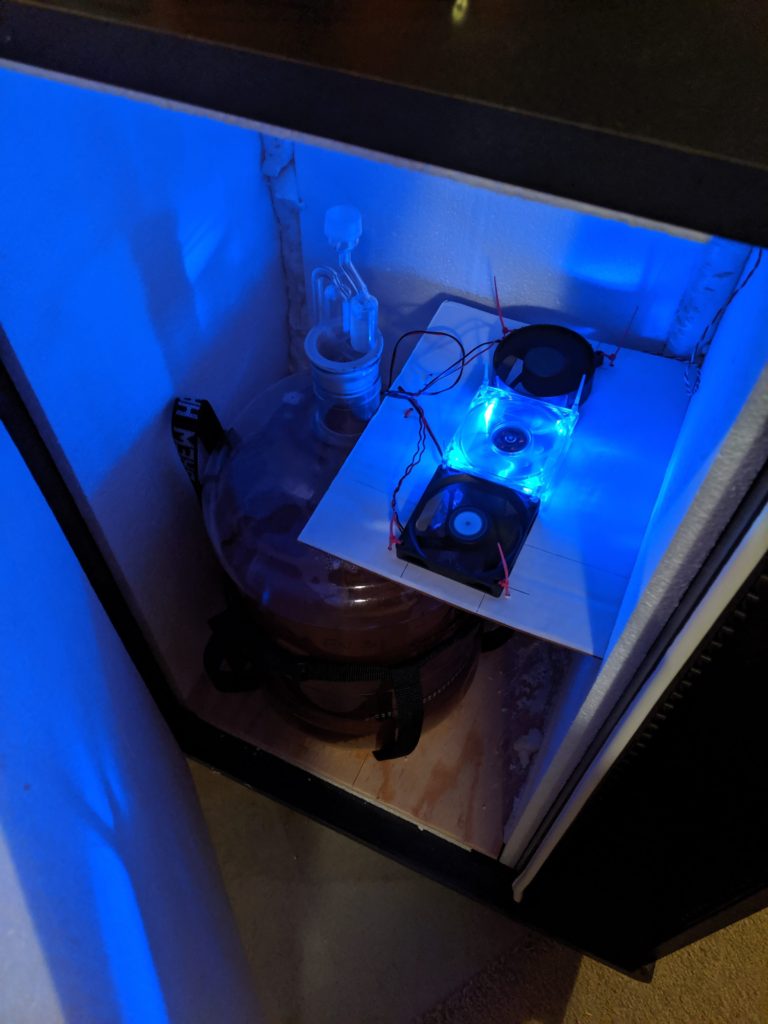
Yes, I had a lighted fan 😎 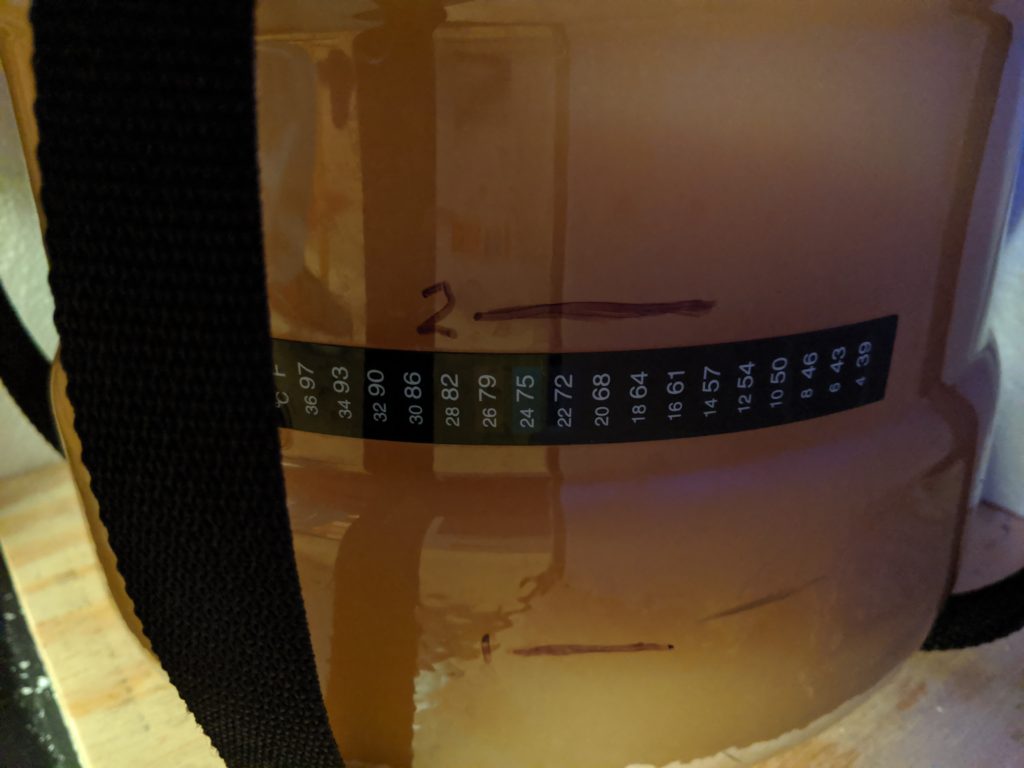
75… uhhh… 😕
Fast forward to Thursday, less than a week after the Saturday brew day. The airlock activity has ceased and the krausen has fallen. I pull a sample for a hydrometer and it’s 1.007. I taste the sample expecting a fruity fusely mess. Nope. It’s slightly fruity, but no fusels detected. I moved the fermenter into the keezer for lagering. My expected FG was 1.011, so clearly my mash temp was a little low… I adjusted the recipe to a light body profile and it dropped the FG to 1.009, so pretty close.
After lagering for a few days, I did pull another sample and it tasted a little green (acetaldehyde). It needs more lagering time than a week, but that’s expected.
After I removed the fermenter, I left the keezer on and put a temperature probe in through the door and left it for around 12 hours. Clearly I need to do some work on things, since it can only keep the chamber down to 68 🤷♂️.
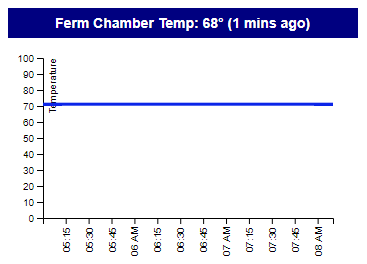
I’ll need to do more work to do some better insulation – part will be an improvement in the sealing around the door, and I’m going to pull out the styrofoam and add better insulation that I have leftover from my office build project.
Review
Appearance: Hazy yellow with a fluffy white head
Aroma: Fruity, apple, grainy
Taste: Malty and fruity. Some apple and vanilla. Very restrained bitterness does not represent anything remotely close to the claimed 59 IBU.
Mouthfeel: dry, thirst quenching.
Overall: very easy to drink. Would prefer a tad more bitterness (the fl
Next version: I’m likely going to double-up on the bittering charge, as this just isn’t as bitter as I wanted. I like it, but it’s not what I really was aiming for. 🍻
DIY Spunding Valve Setup!
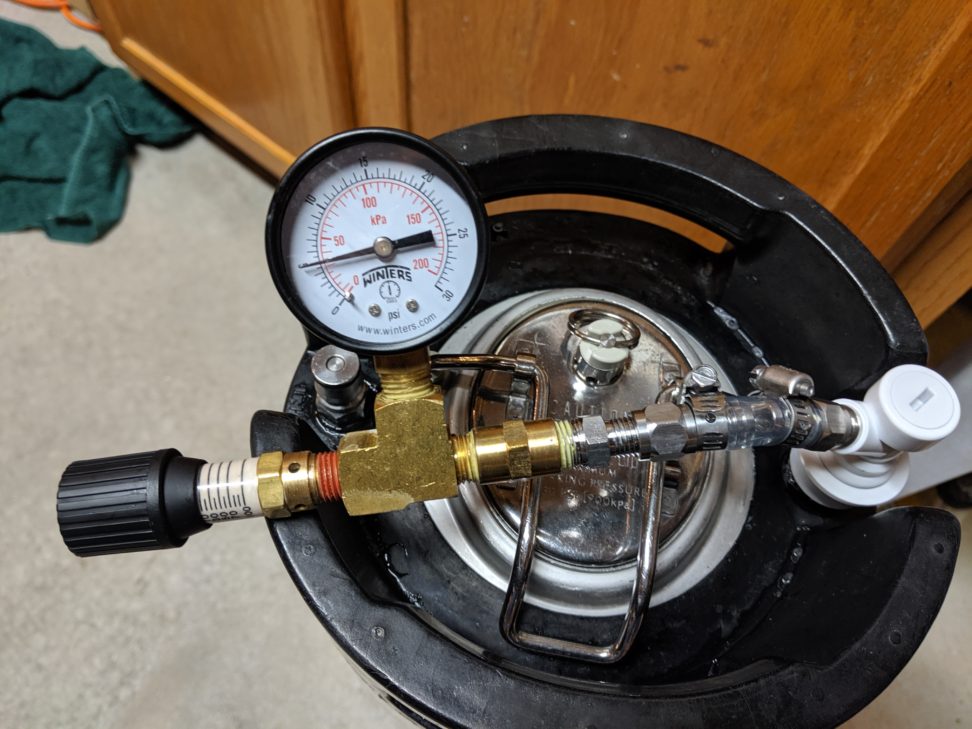
After sitting in a pool drinking a can of Sam ’76 that a friend gave me, I decided that I do want to be able to lager. However, my basement is currently a mess and I don’t have room for anything like another chest freezer. Enter pressure fermentation. There is some scientific evidence that pressure fermentation reduces esters from yeast (although there’s some anecdotal evidence that yeasts like W-34/70 can handle fermentation at room temperature (and I’ve made a Tropical Stout with Wyeast 2124 Bohemian Lager and fermented it at room temperature… which is claimed to be the liquid version of W-34/70).
Spunding valve setups are pretty easy to make – at it’s most basic, it’s just a spunding valve connected to a keg post. Since people generally want to know what pressure they’re at (that can become really important), a smart thing to do is add a pressure gauge in the setup.
I happen to have an extra ball-lock keg that I used once in a kettle sour process. I did have to replace the lid with a new one, and I bought new O-rings (I kept the old ones in a bag marked “sour”, because I’m sure I’ll be making more sour beers too). I also had to buy some posts and disconnects.
From the post, there’s a short length of hose to connect to some adapters and then to a T connection, which has the pressure gauge off the top and the spunding valve at the side. I used a liquid thread sealant on all threaded joints, although I imagine teflon tape would have been fine as well.
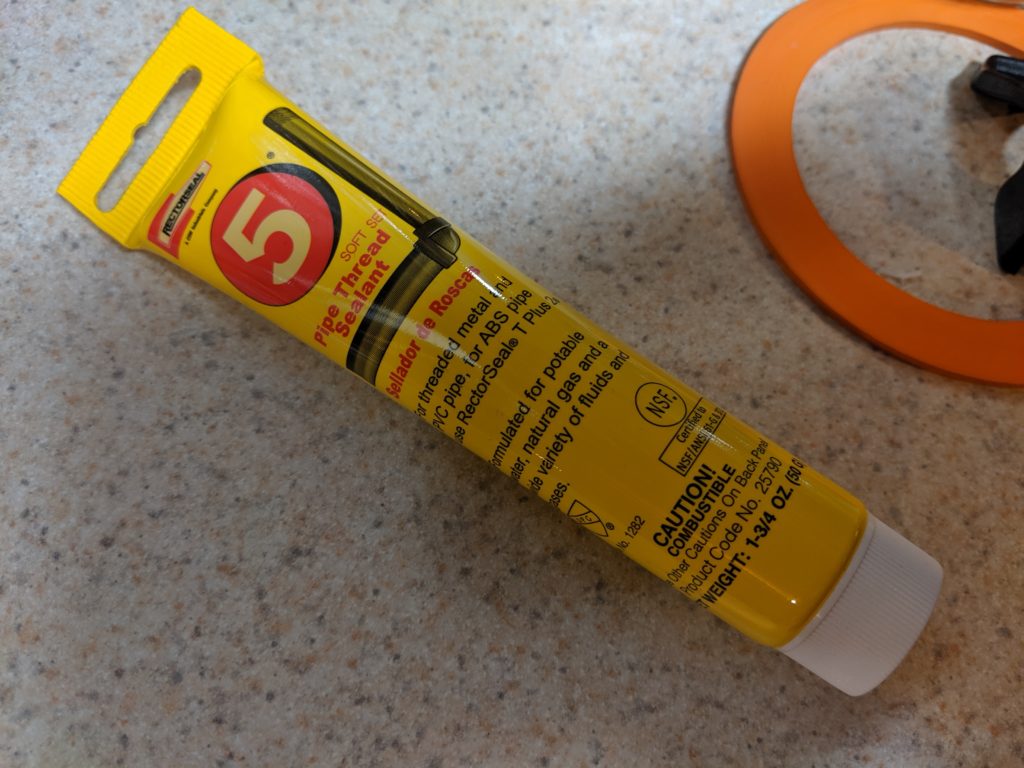
After some false starts with the posts being reversed (I usually use pin-lock kegs), I got it to hold air – it held 5 PSI for quite some time before I started typing this, and it was still at 5 PSI when I finished typing.
Cheers!
Mango Vanilla Milkshake IPA Brew Day
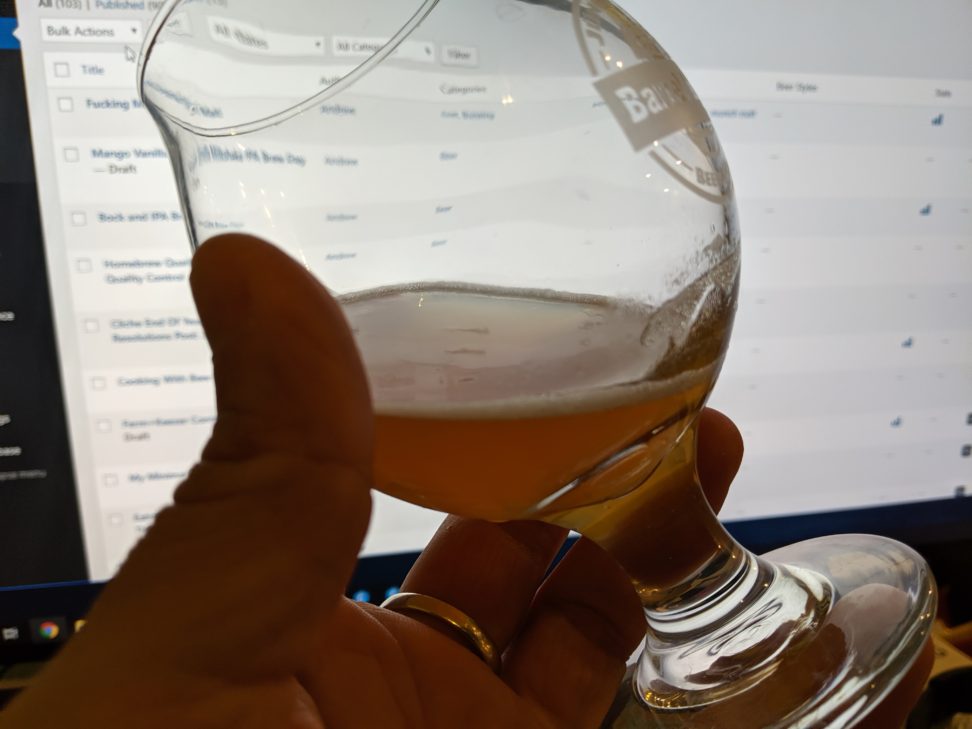
Sometimes you’re Two Hearted. Sometimes you’re Natty Light. This brew day felt more like Natty Light.
I was not actually ready to brew. I had most of the ingredients. I had the yeast I wanted to use. I had most of the hops I wanted to use. I had the mango. I had both vanilla beans and a vanilla tincture. I didn’t have water put out, but I had Campden Tablets… which I had to look for.
I also am trying to make small improvements in my brew day. I’ve been adding tri-clover fittings to everything… the decision to use this type is due to my boil kettle having that type – and I want only one system.

In addition to the tri-clover fittings, I had a three-way valve. Something I’ve never used.
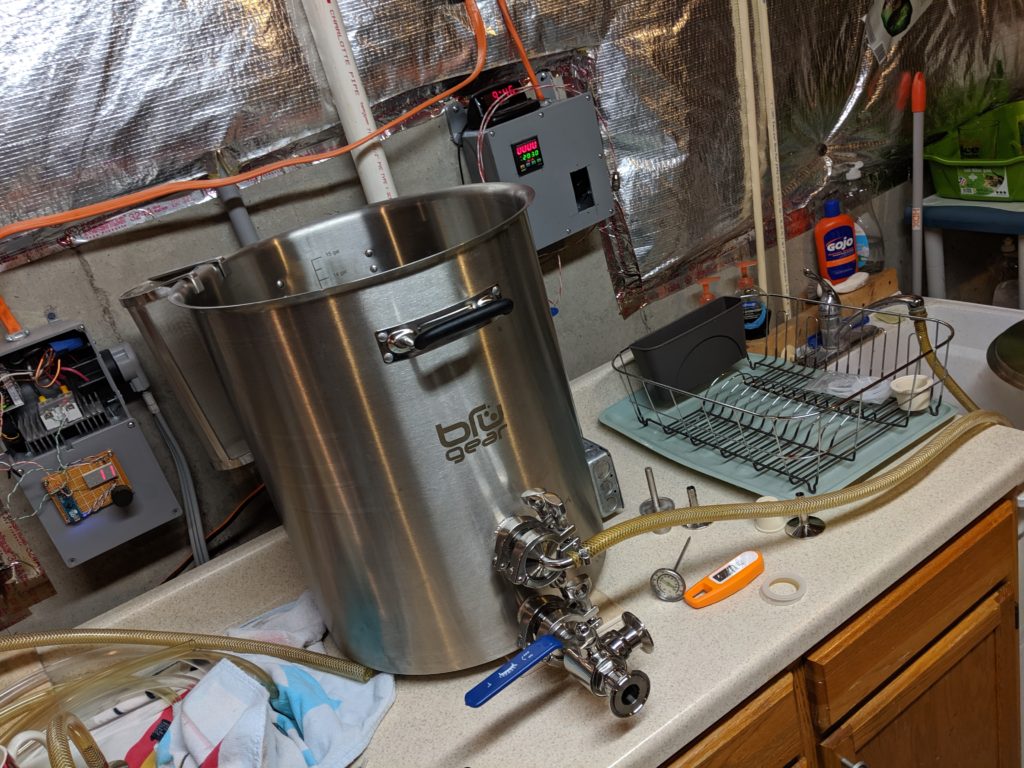
So I start getting the HLT heated up (and it’s temperatures are not reading correctly, as I found in my last brew day), and getting some water started to pre-heat my mash tun. At that point, I decided to mill my grain. My system for this is really shoddy – I have my mill mounted to a too-thin piece of plywood with nothing to ensure that all the milled grains go into a bucket. Usually, I can get all the grist into the bucket. This time was different, I lost a fair bit to the floor.
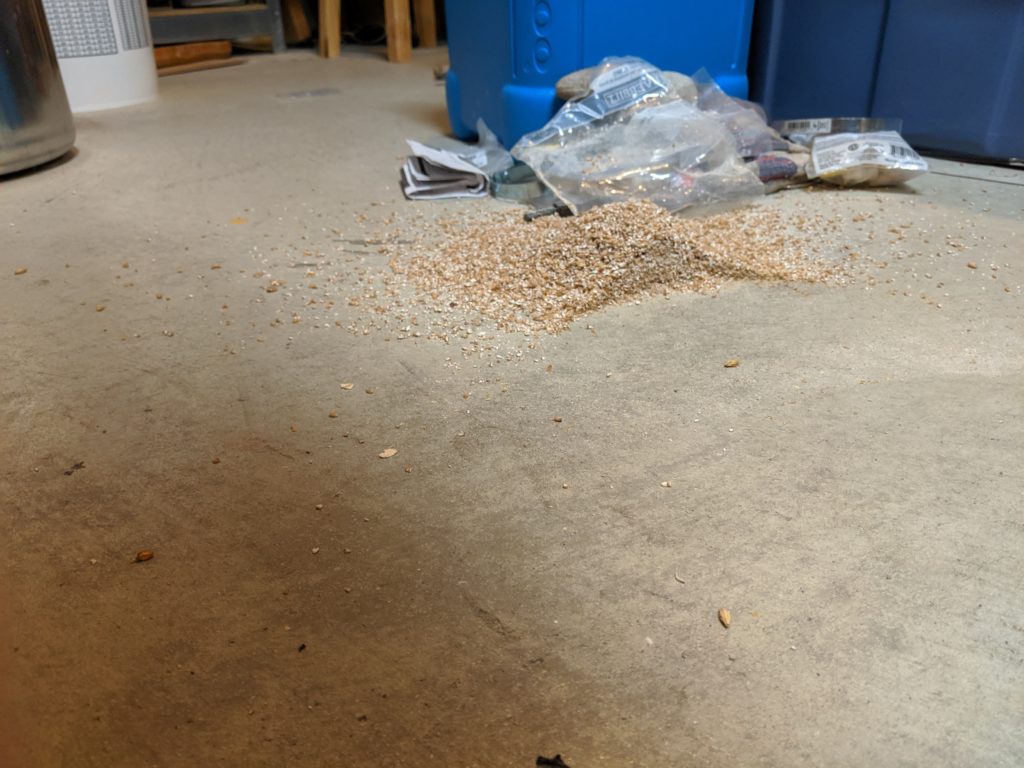
I mashed in and hit my temps and somewhat close to my gravity numbers… given that I had a bit of malt sitting on the ground that went into the trash can.
Then I got to 15 minutes remaining in the boil. I added a late charge of hops and started setting up for a whirlpool and to run hot wort through my new counterflow chiller… and I was one tri-clover clamp short. I tried to adapt by attaching my pump directly to that new three-way valve. As soon as I powered up the pump, it started squealing so I turned it back off. After much finagling, I got the pump running on the “wrong” side of the chiller. I would have preferred to have the pump between the kettle and the chiller… I was able to get stuff running by having the pump between the chiller and the whirlpool inlet. I then added the whirlpool hops and (oops, late) lactose.
I had a very weak whirlpool that made me concerned, but I let it go… and it did chill. I got the wort down to around 85 and had difficulty getting the three-way valve to send the wort to the fermenter. After finally getting it there, I pitched some Omega Hothead Kveik.
After two weeks in the fermenter, I added mango. I used 5 pounds of frozen cubes that I slightly thawed in my microwave and then pureed in the blender (sanitized, of course) and dumped the puree in via a funnel. A few days later, after the secondary fermentation kicked off, I added around 8 ounces of vanilla bean tincture (cheap vodka aging 4 vanilla beans that were sliced open). I had so much difficulty with getting samples that I cold-crashed the fermenter and kegged without too much tasting. I was half a gallon low into the fermenter (I target 5.5 gallons in the fermenter any time I dry hop). I lost a gallon to fruit. Maybe it would have been better if I cold crashed longer, but I’m not sure.
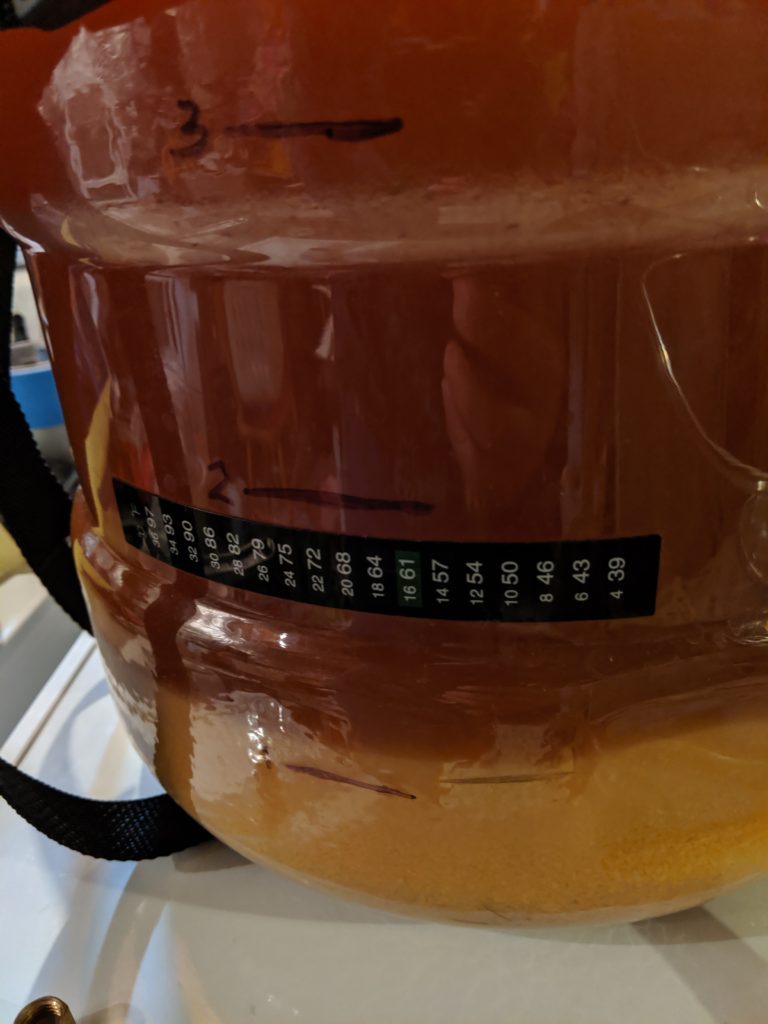
I kegged it on July 7 with some keg hops. I was hoping that I could take it to a homebrew club meeting on July 11. Between running out of CO2 and green hop flavor, it wasn’t happening.
The aroma is vanilla and tropical fruit, obviously dominated by mango. The appearance is opaque copper. Once properly carbonated and aged to allow the hops to meld a little, the flavor is quite nice – the slight carbonic acid bite actually works well here. There’s a lot of hop flavor, little bitterness (but there is some), and some vanilla that comes in late. There is a sweetness to it, which is as expected. The mouthfeel has a slight thickness, which works well for the style but could probably use to be amplified.
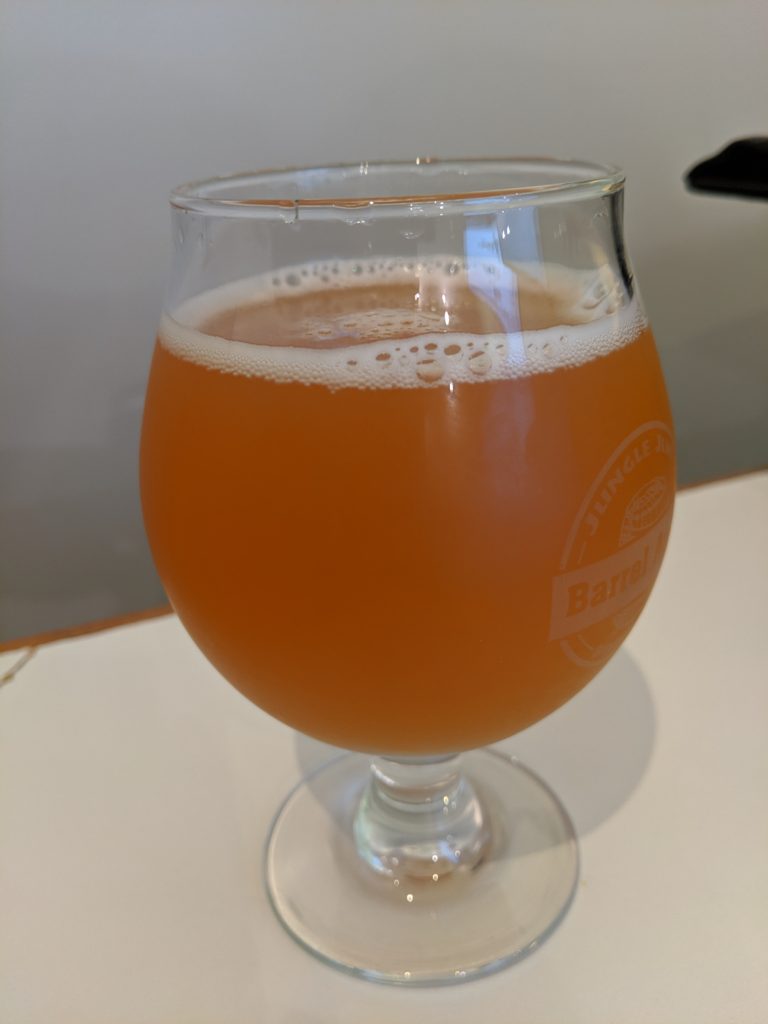
Cheers!
Fucking Munich Malt!
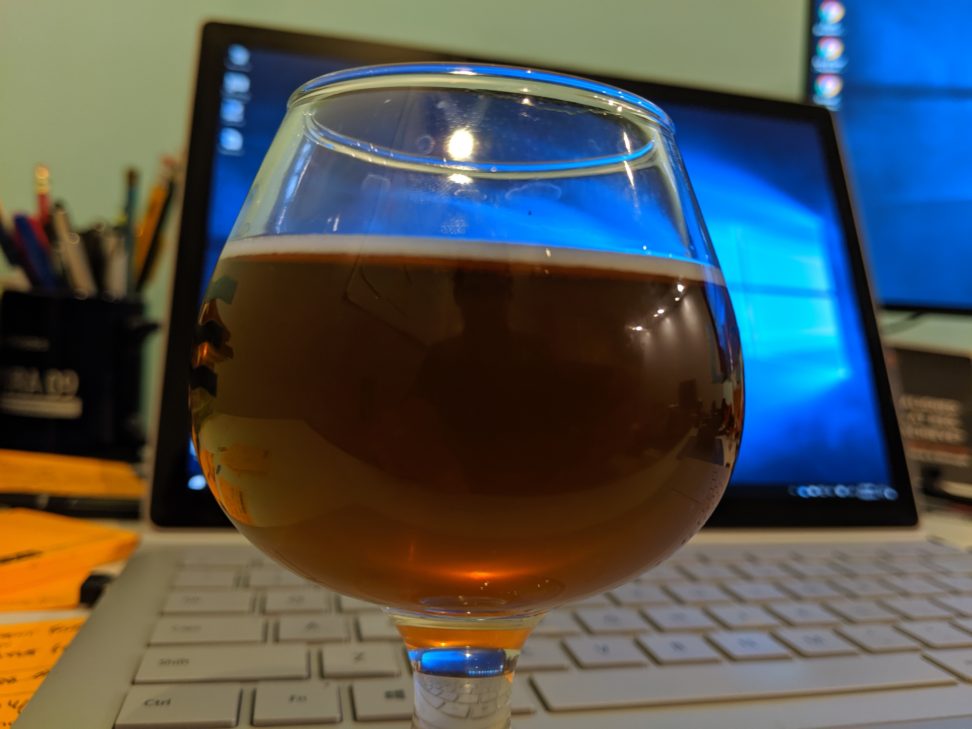
Every time I’ve brewed with Munich malt, I’ve had a problem of what seems to be acetaldehyde (or maybe it’s just ‘green’) flavor in the beer. There hasn’t been many, and these have not been brewed consecutively. Brews between these have NOT exhibited the same flavor, and the flavor does fade after time.
Brew 1: British Mild
This was brewed on 9/3/2017 and was supposed to be a partial fresh-hop (Chinook) IPA, propped up with some Chinook pellets. The hop character wasn’t as extreme as an IPA and I ended up using some S-04 mixed with an un-inflated bag of Denny’s Favorite (long story). I noticed the acetaldehyde flavor, as did a judge or two at a competition. I liked the beer, though, and drank the heck out of it.
Brew 2: Dunkelweisen
This was brewed on 12/17/2017. This beer was all over the place, and at one point had a distinct Festbier taste, probably from the aroma hops I shouldn’t have used. I recently (at time of writing) opened an old bottle and it’s way too bitter for a Dunkelweisen.
Between brews 1 and 2, I brewed an IPA. No Munich Malt in that one, and no acetaldehyde-ish flavor.
Brew 3: Bock
This was brewed recently (12/27/2018), and it was a door prize from my homebrew club. It ultimately got over the sweet flavor to end up as a damn good beer that won a gold medal in the Bloatarians Bockfest Competition.
Between brews 2 and 3, I brewed a Flander’s Red (still in the fermenter), a pale ale (had a different off flavor later found to be due to improperly cleaned equipment), a tropical stout (no off-flavor, no Munich Malt), and a pale ale (no off-flavor, no Munich Malt)
Brew 4: Fuck Munich Malt Beer!
The two common threads the above beers have is the same LHBS and Munich Malt. So I decided to test this out with a beer somewhat reminiscent of that British Mild above, but with a little bit more backbone. I purchased the grist from a different LHBS.
Recipe was simple (but not simple to get from BeerSmith on my iPad to WordPress). This is for 5 gallons into the fermenter:
10 lb Maris Otter
1 lb Munich 10
0.5 lb Crystal 60
0.6 oz Magnum @ 60 min
1 oz Fuggle @ 15 min
1 oz Falconers Flight 7Cs @ 5 min
1 pack Wyeast 1318 – London Ale III
I made a change to this brew day – I added some stainless. I bought two pickup tubes – one for the bottom of my kettle and one for the top. The bottom is to get more wort with less tilting. The top is to form a whirlpool during the final 15 minutes when I recirculate through my plate chiller to sanitize it.
Brew day was somewhat frustrating. First, my thermometer disagreed with my PID… and I’m not 100% sure which one was correct. Ordinarily, I’d go with the thermometer, but later this happened…
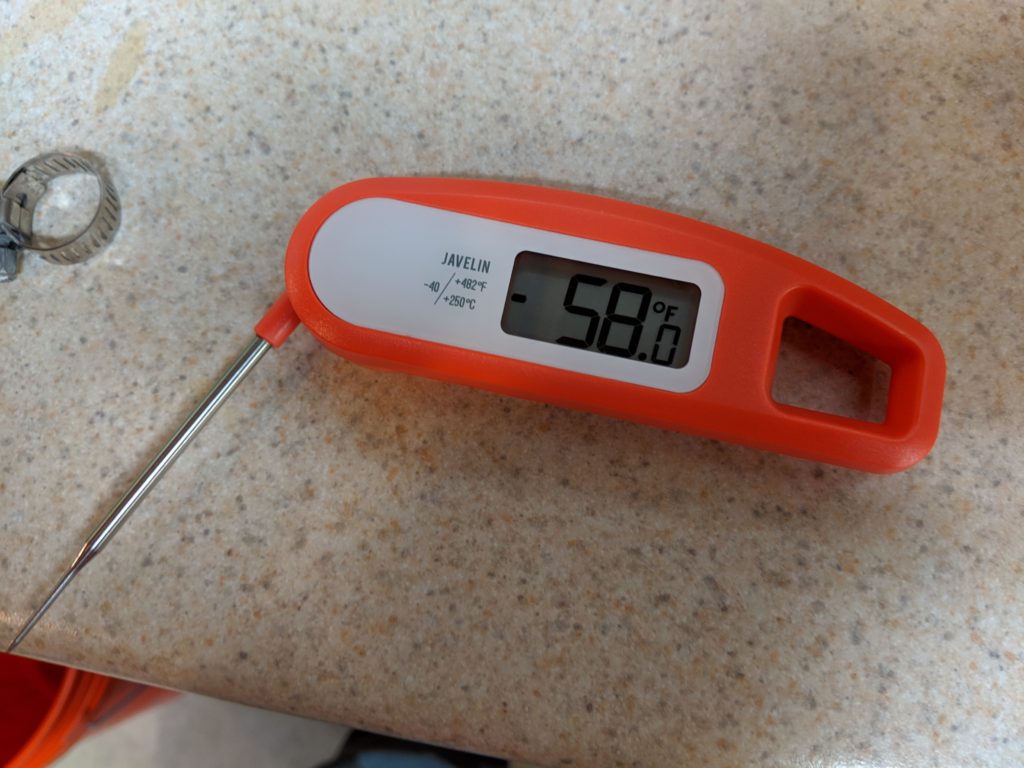
Then my plate chiller (which is a 🤬🤬 piece of 🤬🤬 🤬🤬🤬🤬 🤬🤬 🤬 🤬🤬 🤬🤬🤬 🤬🤬🤬🤬… and don’t even ask what a ‘🤬🤬🤬’ is!) clogged. Had it not, that new stainless would have had a damn good whirlpool. Given my frustrations with cleaning it (it likes to hide break material and hop material no matter what I do to clean it), I broke down and bought a counter-flow chiller the day after brew day.
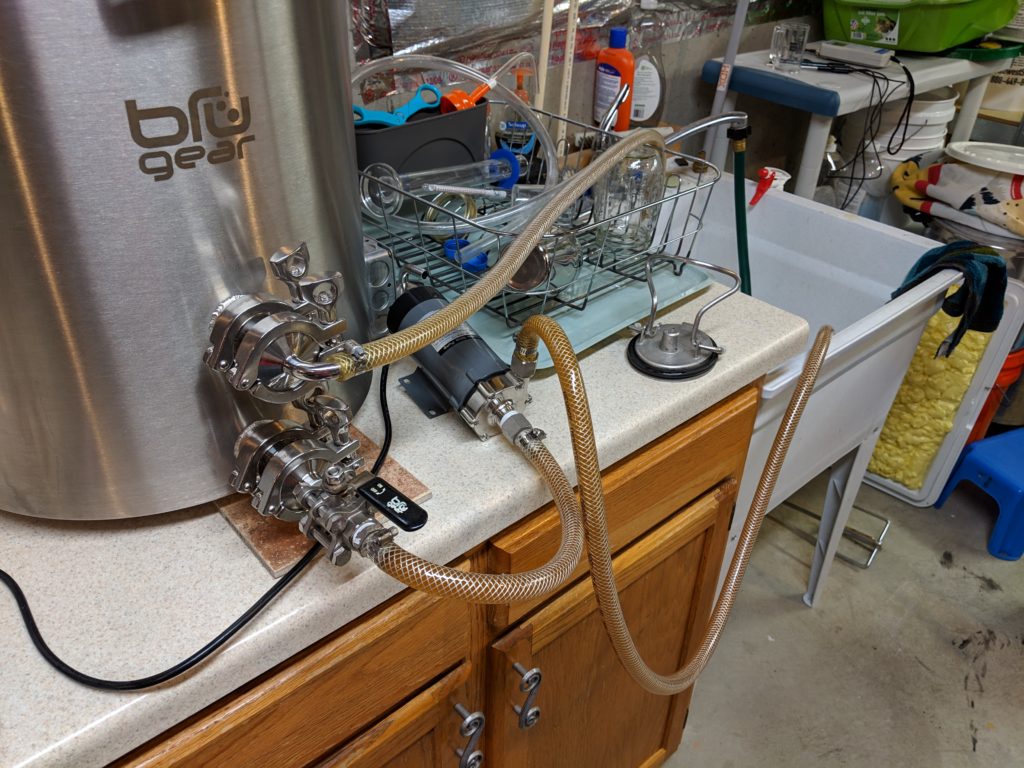
There was another issue. I thought about how I’d make a whirlpool, but did not think about how I would get beer into the fermenter. Oops. I’ve bought more stuff from Brewer’s Hardware to fix that, too.
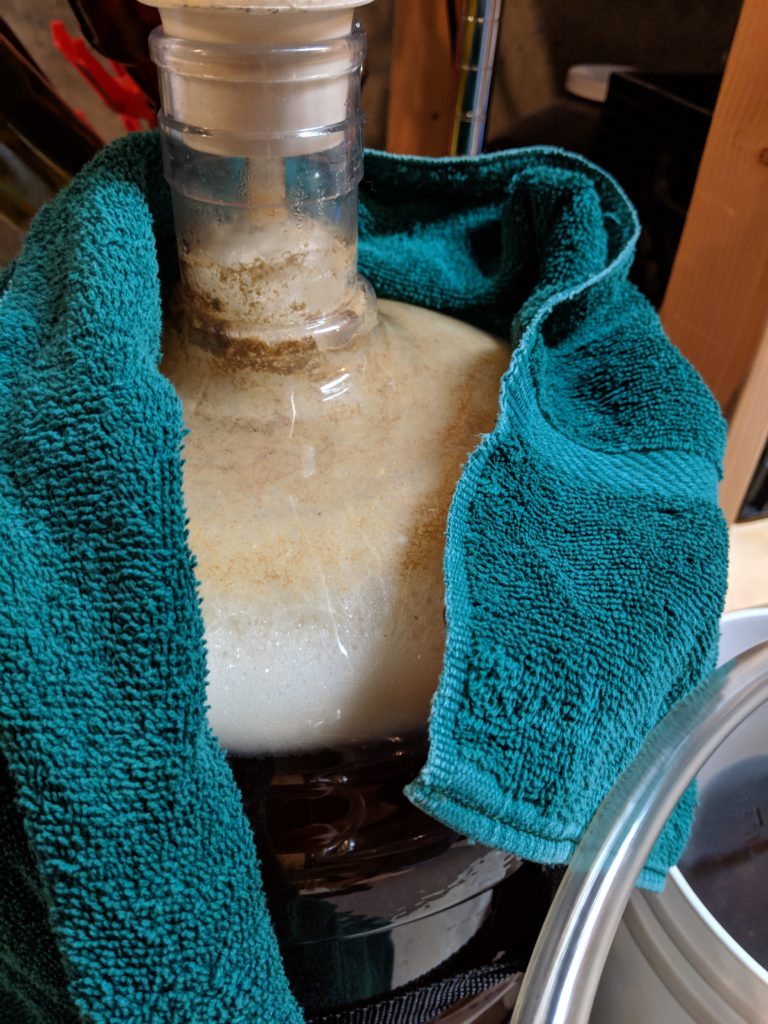
This ended up staying in the fermenter for a while, and during various tastes, I DID pick up on that overly-sweet flavor. Somewhere (I don’t remember if it was a podcast like Experimental Brewing or talking with a friend+brewer or homebrew club buddy), I got the idea that it might be a yeast phenol. I ended up leaving it in the fermenter for an extra week or two. The flavor faded, which makes me think that it is a yeast-based off-flavor. The British Ordinary Bitter that I ultimately kegged was quite tasty after the extra conditioning time.
The appearance is hazy with a copper color with a white head. The aroma is slightly hoppy with some nondescript malt. The flavor is bready and cherry, and is really quite nice, and there is a slight bitterness on the end that has a slight woody quality. It was a bit of a hit at a homebrew club meeting.
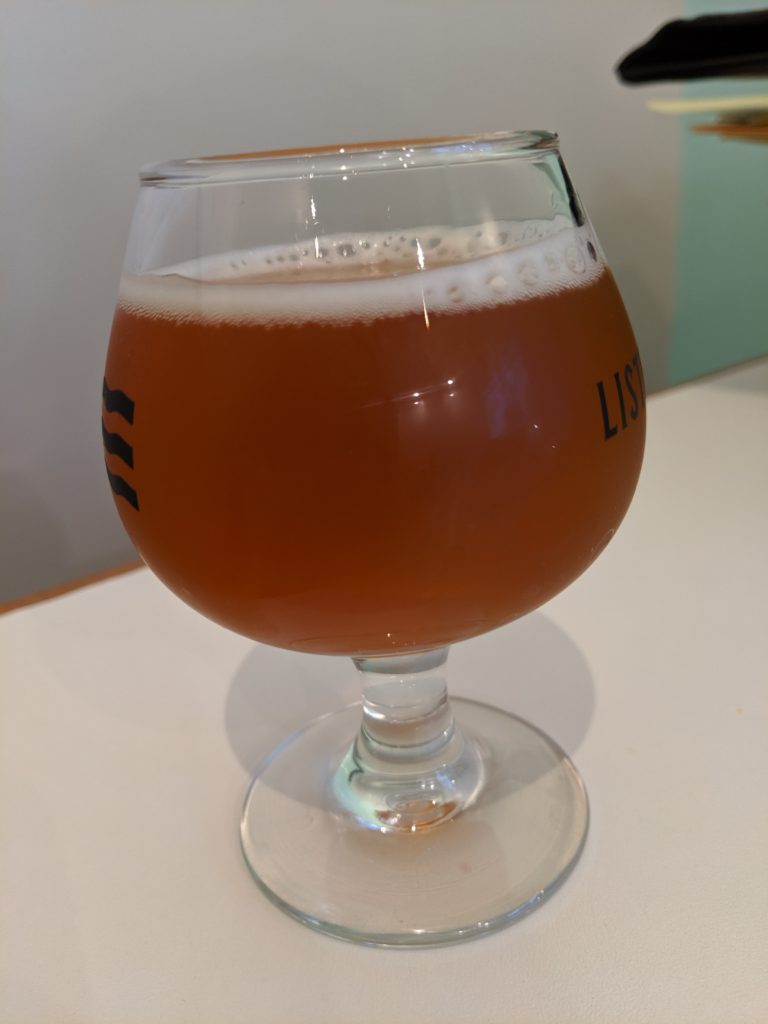
Back to that “Fuck Munich Malt” Part…
As is similar with the others, I brewed a few things between brews 3 and this brew – an IPA and a Saison, neither have an off-flavor or Munich Malt, and after this brew, I brewed a milkshake IPA with no off-flavor and no Munich Malt (the flavors are pretty strong in that, so this doesn’t tell us anything!)
So one thing to note is that I *did* taste that off flavor with the malt from the different LHBS – so I feel like it is NOT a problem with either LHBS, it’s a ‘thing’ with Munich Malt. There’s a lot of beers that use Munich Malt that are lagers, and the extended lagering should ultimately drive off the flavor.
Cheers!
Bock and IPA Brew Days
My pipeline of homebrew went dry. I had been in a fine position until I needed to build an office in my basement, which took precedence over brewing. However, I work from home now, and my pay increased as a result 🙂. I’ve been enjoying some commercial beers – we’re truly blessed in Ohio to have such wonderful beers to drink!
Bock Brewday
I won a Dunkles Bock kit as a door prize from the homebrew club Christmas Party. I brewed while working, which was stupidly arrogant. I missed my mash temp by 10 degrees and ultimately did no-sparge because of the amount of hot liquor I had to add to get it to 152, which is lower than I wanted still. And I only got 4 hours of working instead of 8. I’m never doing this again. I didn’t take any pictures (because work).
The beer was ultimately a 5.5% Bock, which is a little light. However, it won first at the Bloatarian Bockfest Competition and after the green-ness wore off, it was a damn good beer!
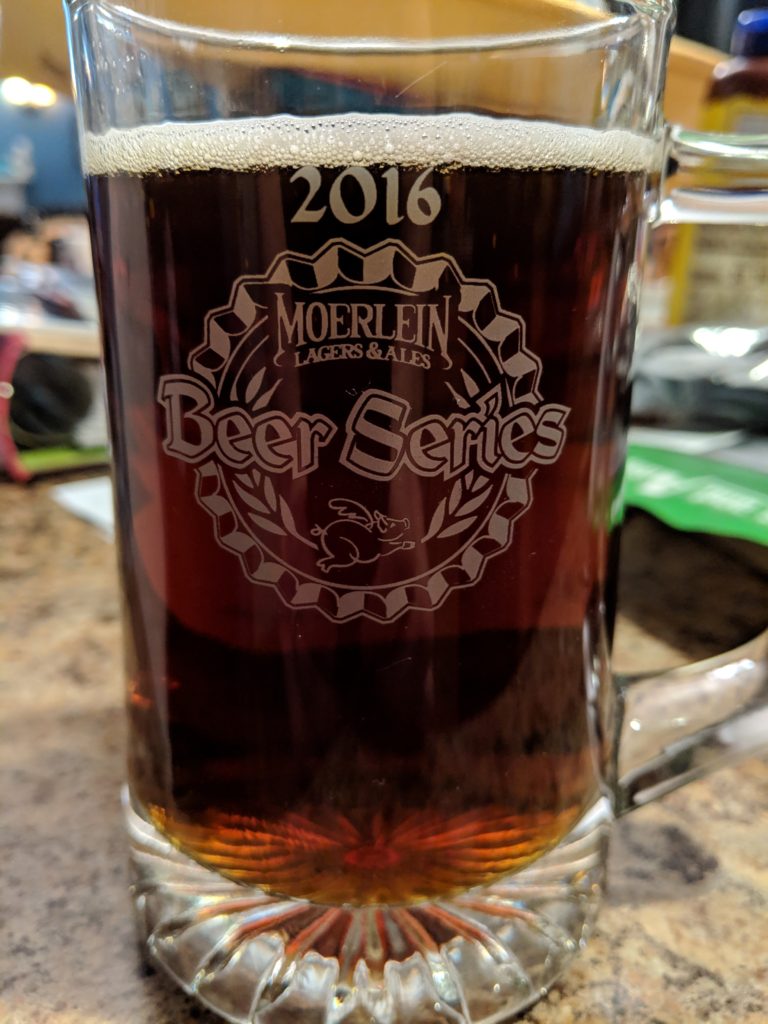
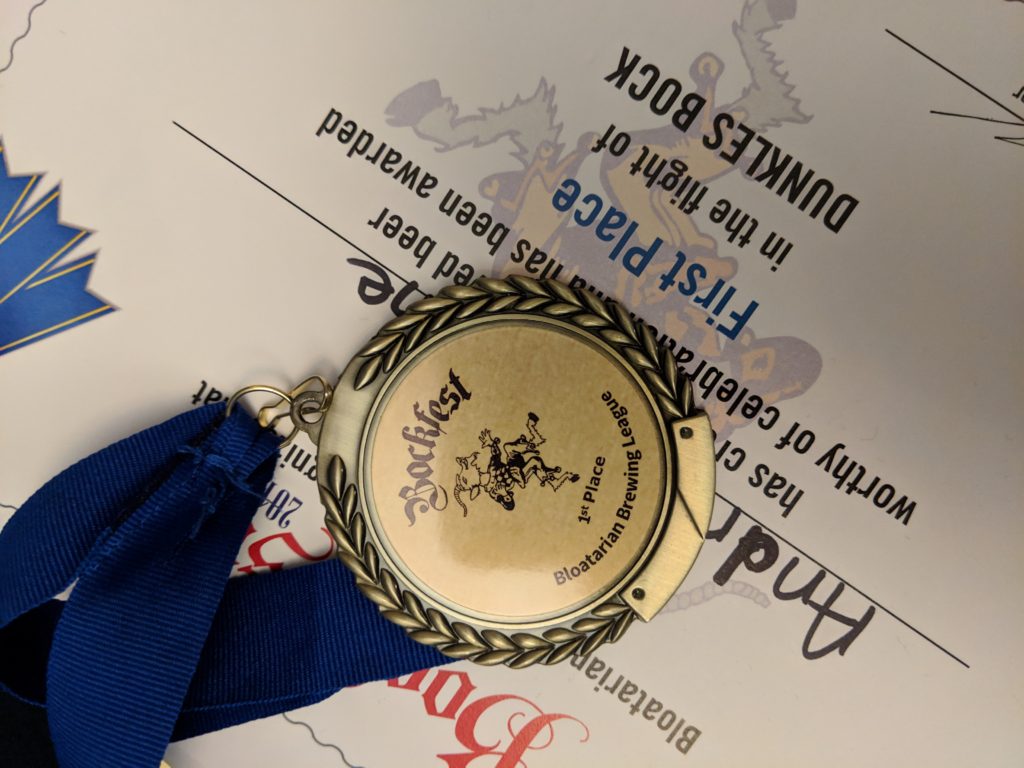
IPA Brewday
This is close to a remake of a previous IPA that I absolutely enjoyed. I’m changing a few things, though- different yeast and no keg hops. Instead of WY Denny’s Favorite, I used Imperial Dry Hop and I used some Citra Cryohops instead of normal Citra. I may have also used less Waimea hops too. This one is not as good as the last one, though.
During the brew day, I overshot my mash temp, starting in the high 150s.
The finishing gravity was way high – like the last time, but higher. I later determined that my mash temp was way too high and likely caused less apparent attenuation (as noted in Zymurgy Nov/Dec 2018 Ask The AHA column, and referenced in the March/April 2019 Dear Zymurgy column.
This isn’t a dumper, though.
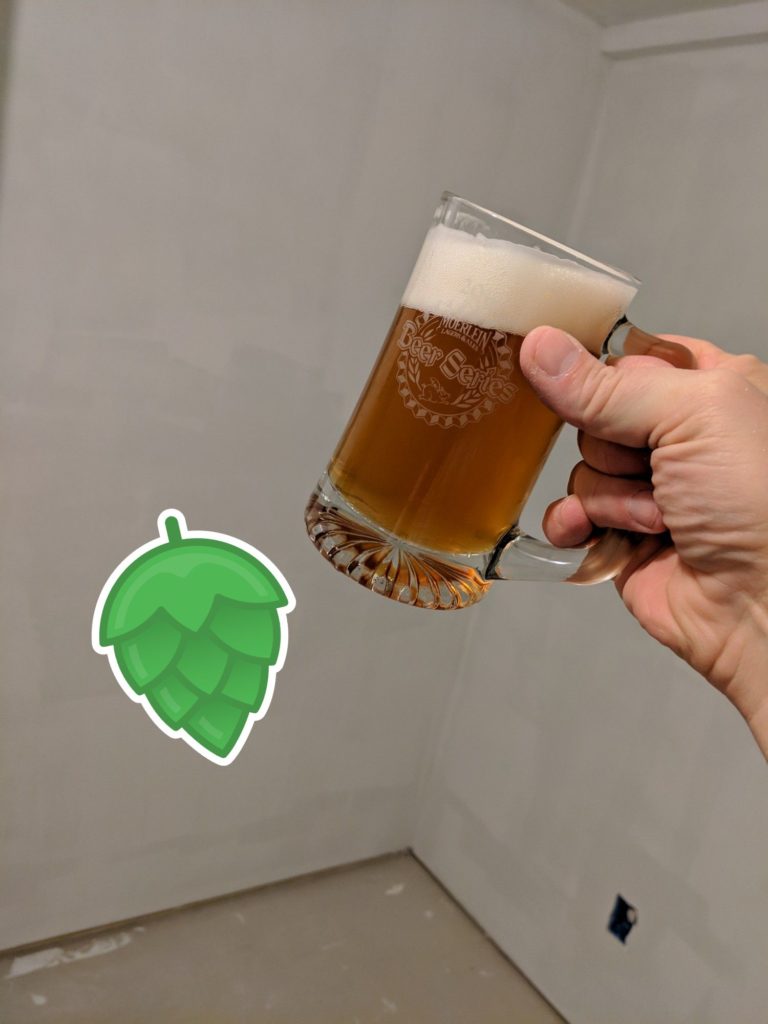
Cheers!
Cooking With Beer: Bison Beer Chili
I’ve had some beer chilis that were downright horrible, but I hit the mark with this.
Background
I like the deeper flavor of bison, and I wanted to make a decent Tex-Mex chili. I started with 3 packs of bison and I knew the sauce base would be stewed tomatoes (thanks to my brother-in-law). This type of chili should have onion, a green pepper (and perhaps a red pepper, although I didn’t), and some garlic. I also used spices to that area – cayenne pepper, chili pepper, cilantro, cumin, chipotle pepper, and black pepper. No salt was used in this recipe, although I’m sure there was some in the stewed tomatoes and tomato sauce. Oh, and I used about half a glass of a malty pale ale. The spices were not to the ‘light your ass on fire’ point, I wanted flavor and some spice, but I wanted it edible.
Recipe and Directions
3 pounds ground bison
1 red onion, finely chopped
4 garlic cloves, minced
1 green pepper, chopped
6 oz pale ale (other light ale may be able to be used, malty likely works best here)
3 cans (14.5 oz or so) stewed tomatoes
1 can (14.5 oz or so) tomato sauce
2 cans pinto beans (drained and rinsed well)
1/2 tsp cayenne pepper
1 tsp cilantro
1 tsp paprika
1/2 T (1 1/2 tsp) cumin
1/2 tsp black pepper
2 T chili powder
1/8 tsp chipotle pepper
Directions:
- Brown the bison, drain if necessary, transfer to crock pot
- Re-oil pan if necessary, add onion and cook
- Add garlic, cook for a minute or two, add beer
- Add green pepper, cook until it’s tender
- Add all pan contents (onion, garlic, green pepper, beer) to crock pot
- Drain and rinse beans, add to crock pot
- Add stewed tomatoes and tomato sauce to crock pot, break tomatoes up while stirring
- Add all spices to crock pot, stir well
- Cook two hours on high, then drop temperature to low for another 4-6 hours
- Serve!
I paired this with the last of the pale ale I used for cooking and corn bread cooked in a cast iron skillet.
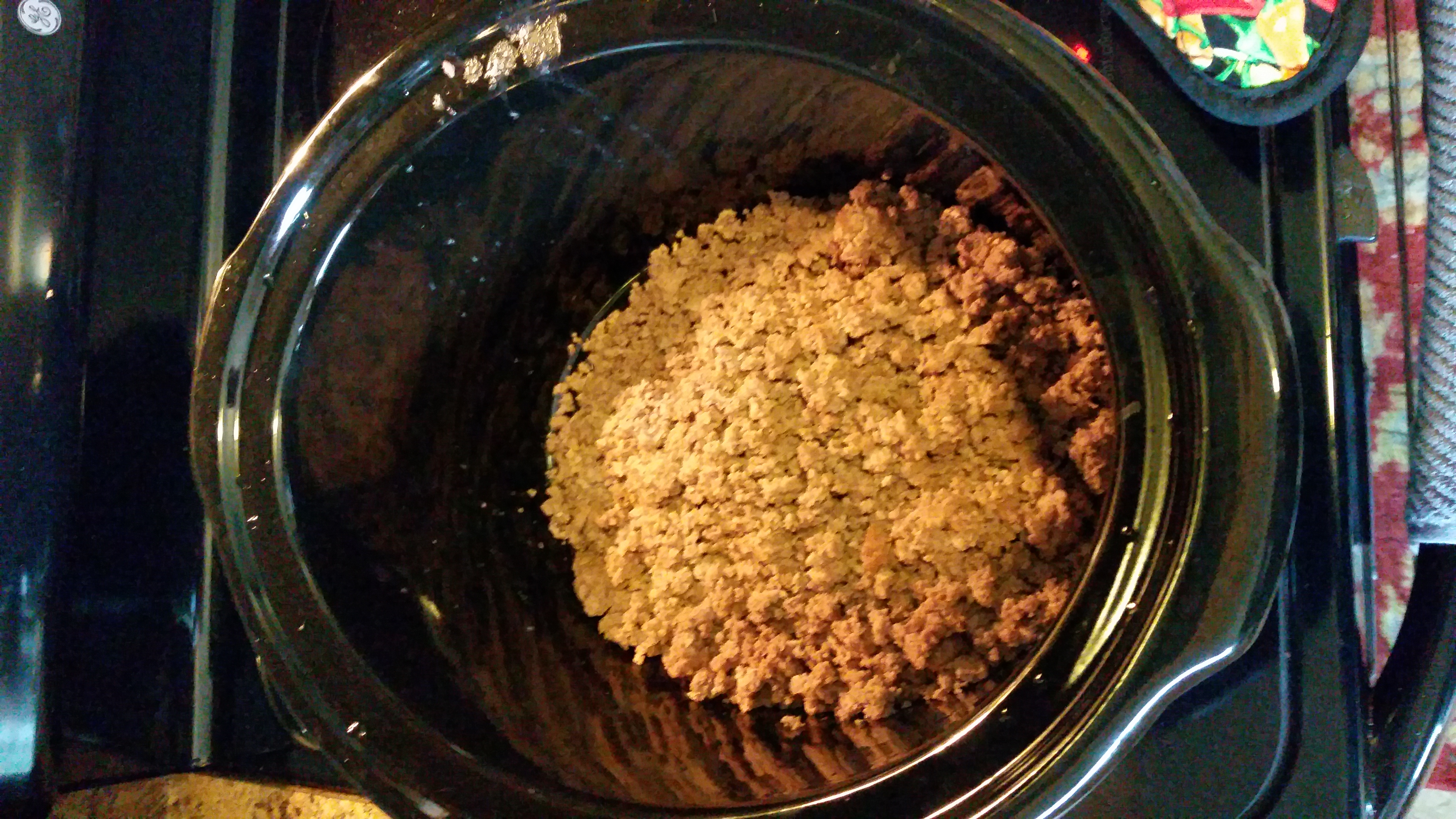
Bison in the crock pot 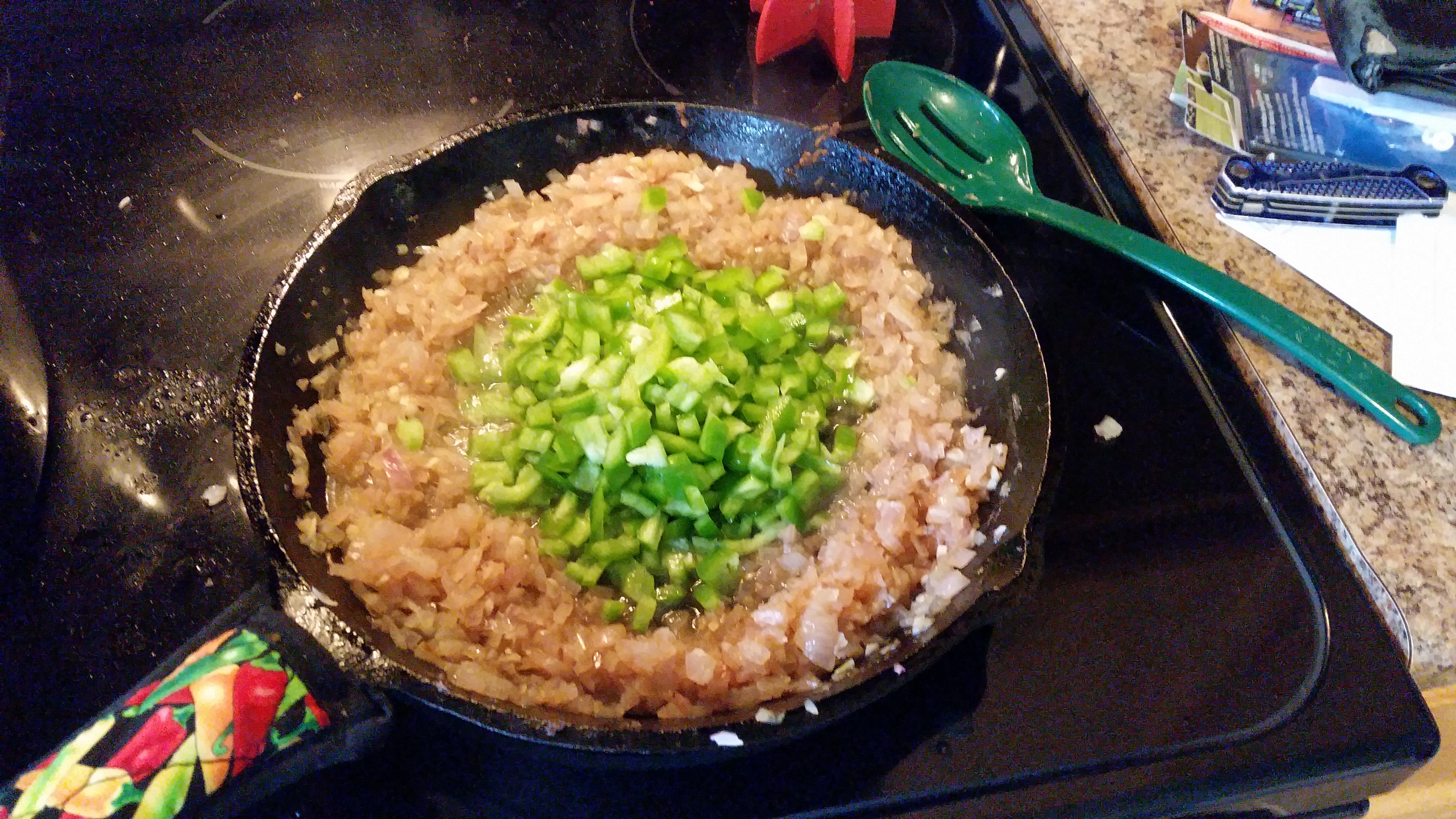
Cooking onions, garlic, and green peppers 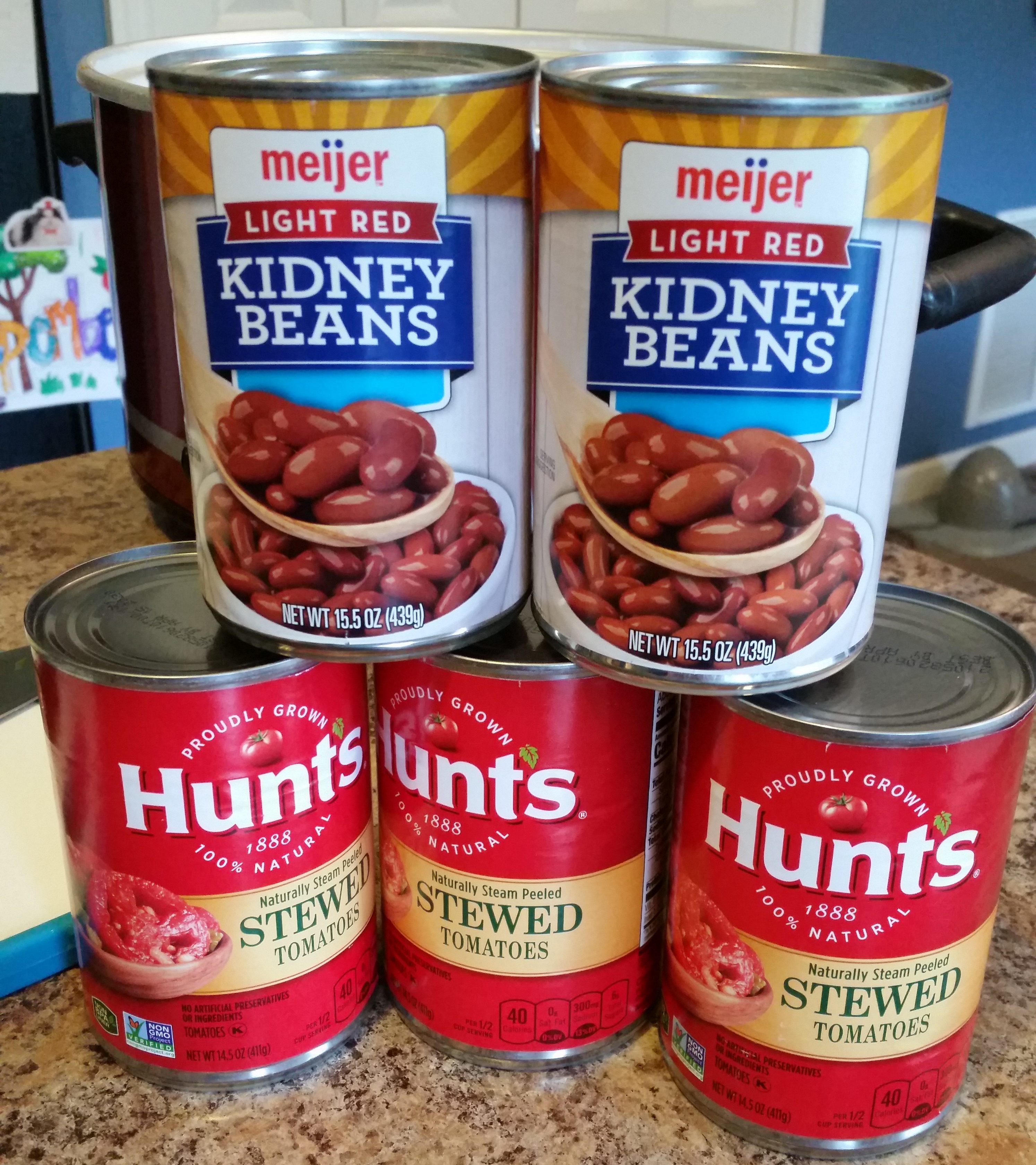
Cans of ingredients 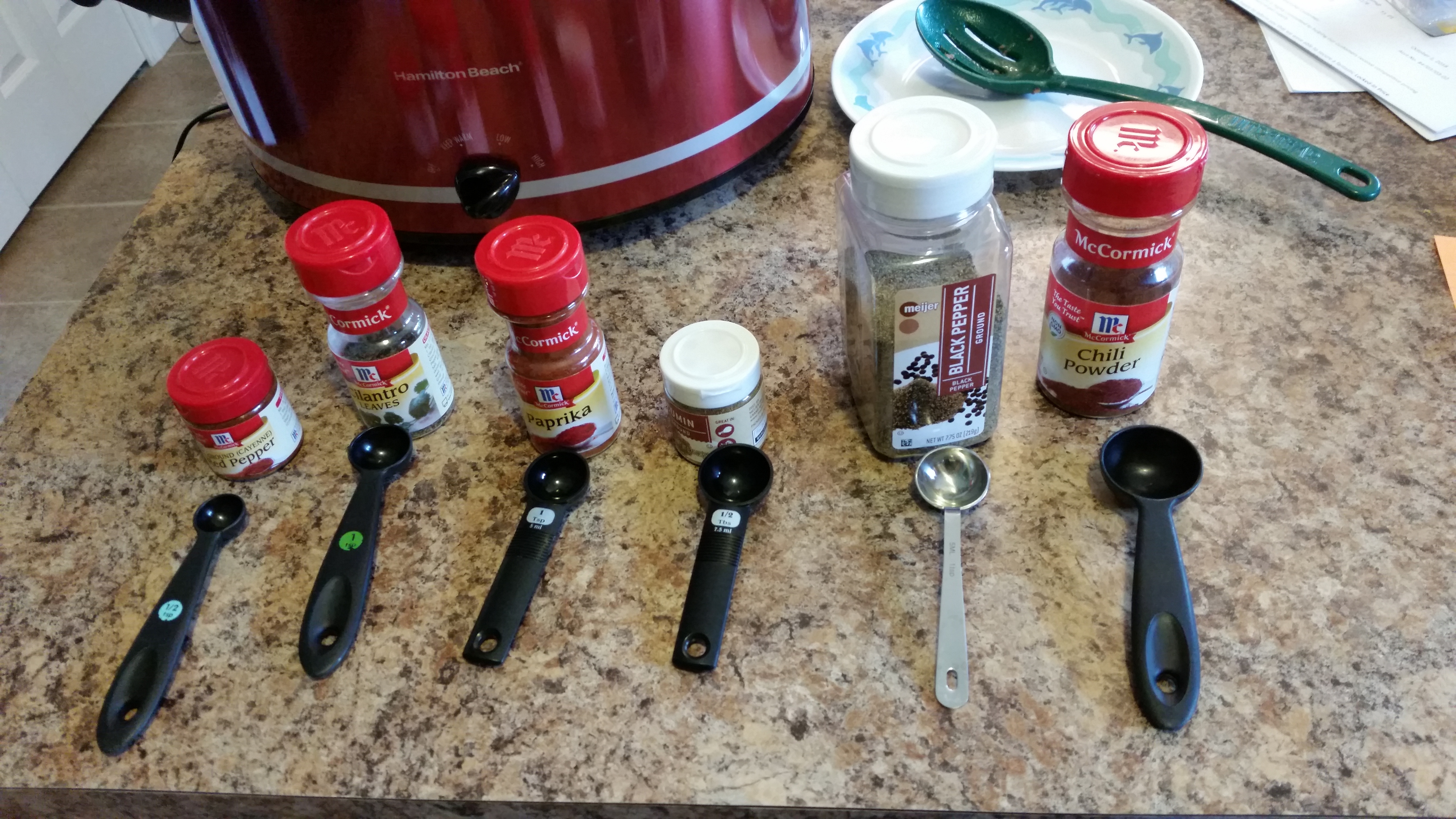
Spices! 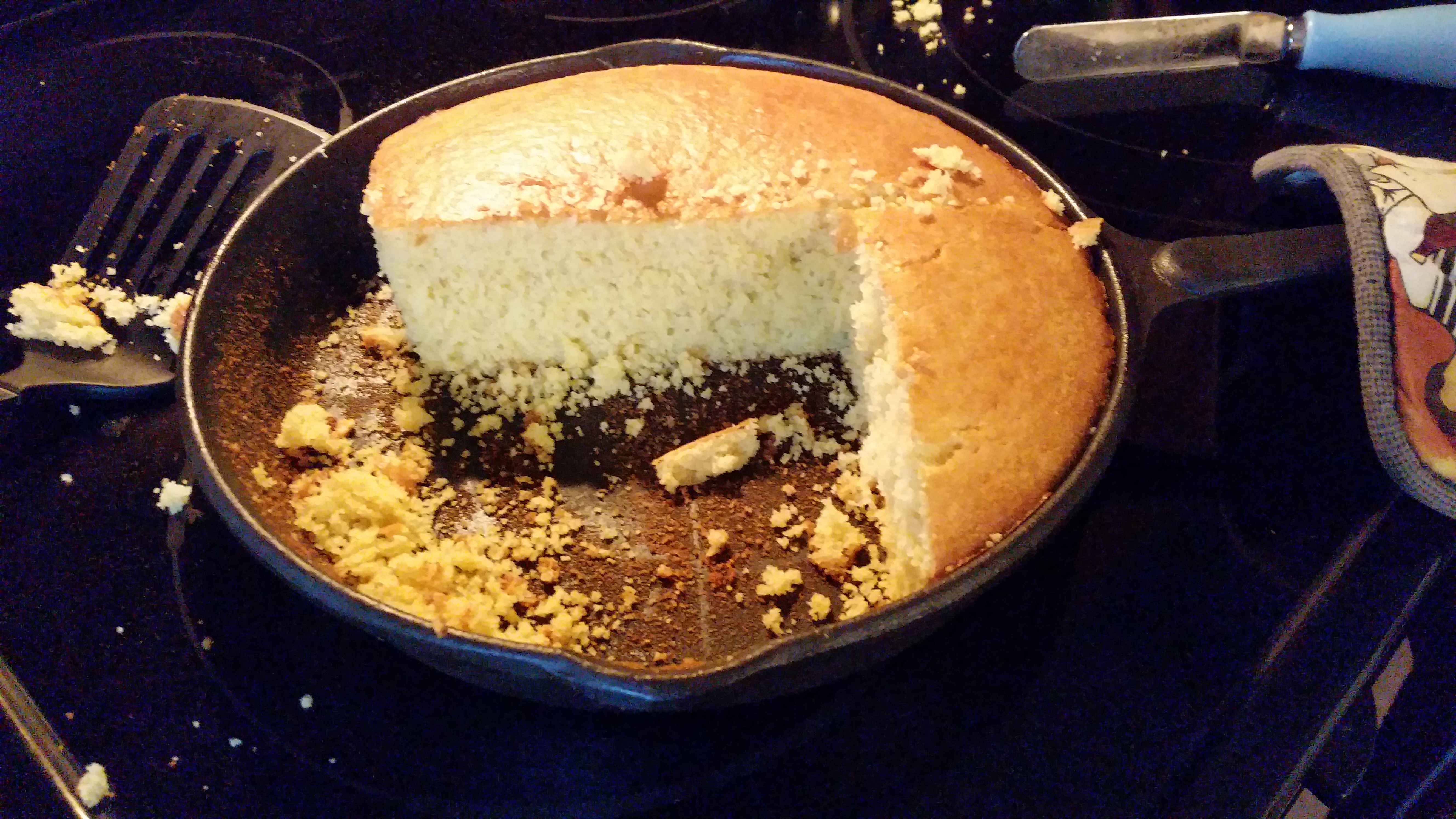
Corn bread! 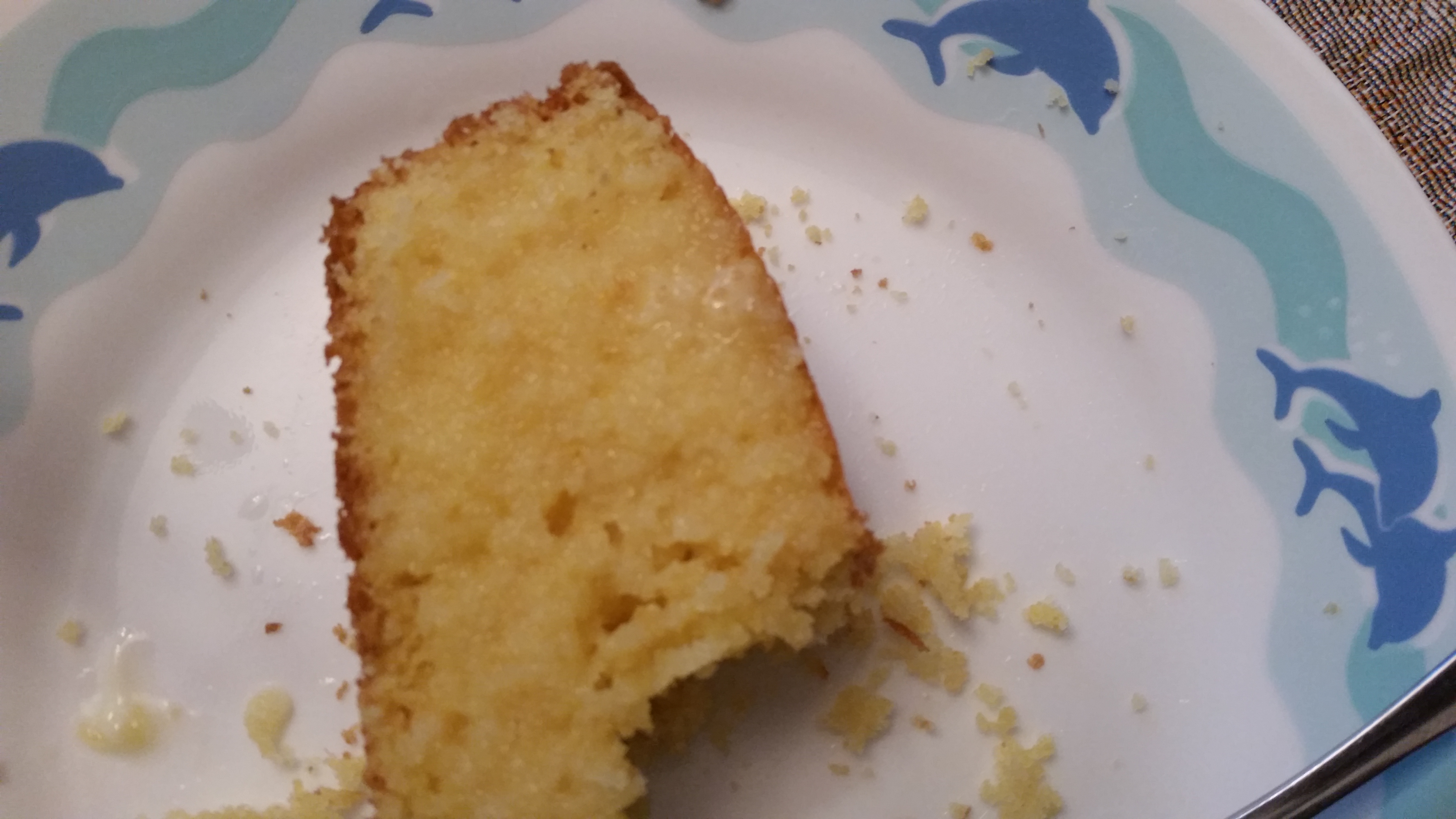
Corn bread! 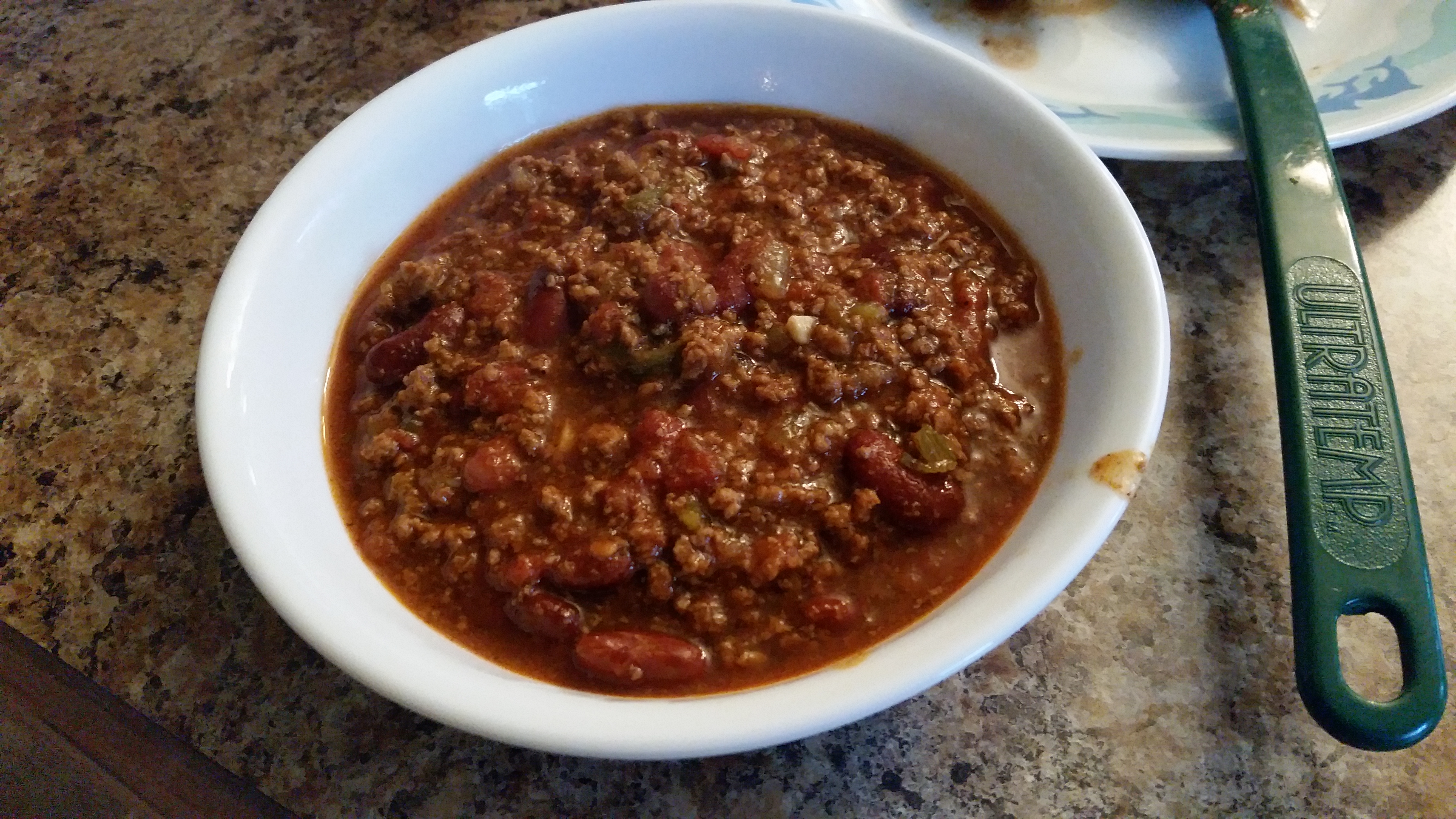
Finished chili
This was a hit with the entire family, and the salt was not missed. Cheers!
My Minimal Oxygen Transfer Method
I made a NEIPA, which I love and hasn’t turned brown… for those unaware, these things oxidize quickly.
I fermented this in a plastic carboy to give me the potential to transfer to a keg with minimum oxygen. This was the first try, so I did have some issues (which are addressed in the procedures, I’m not talking about my screw-ups here).
1: Cold Crash (if possible)
Cold crashing will remove much of the yeast from suspension, and that will likely improve flavor. I skipped this because my fermentation chamber is unable to go below 55 (actually, I’m not even sure if it’ll go below 60, but it can keep an ale at 68).
2: Setup
The basic bare-bones of this is a gravity transfer. That being said, the fermenter needs to be up on something and the destination keg needs to low (like on the floor). You should already have a racking cane in a siphon cap and the other end should be prepared with a CO2 line. Since I don’t have an extra CO2 tank, I fitted mine with a gas post. Make sure you use Oetiker clamps or worm clams on the gas lines!

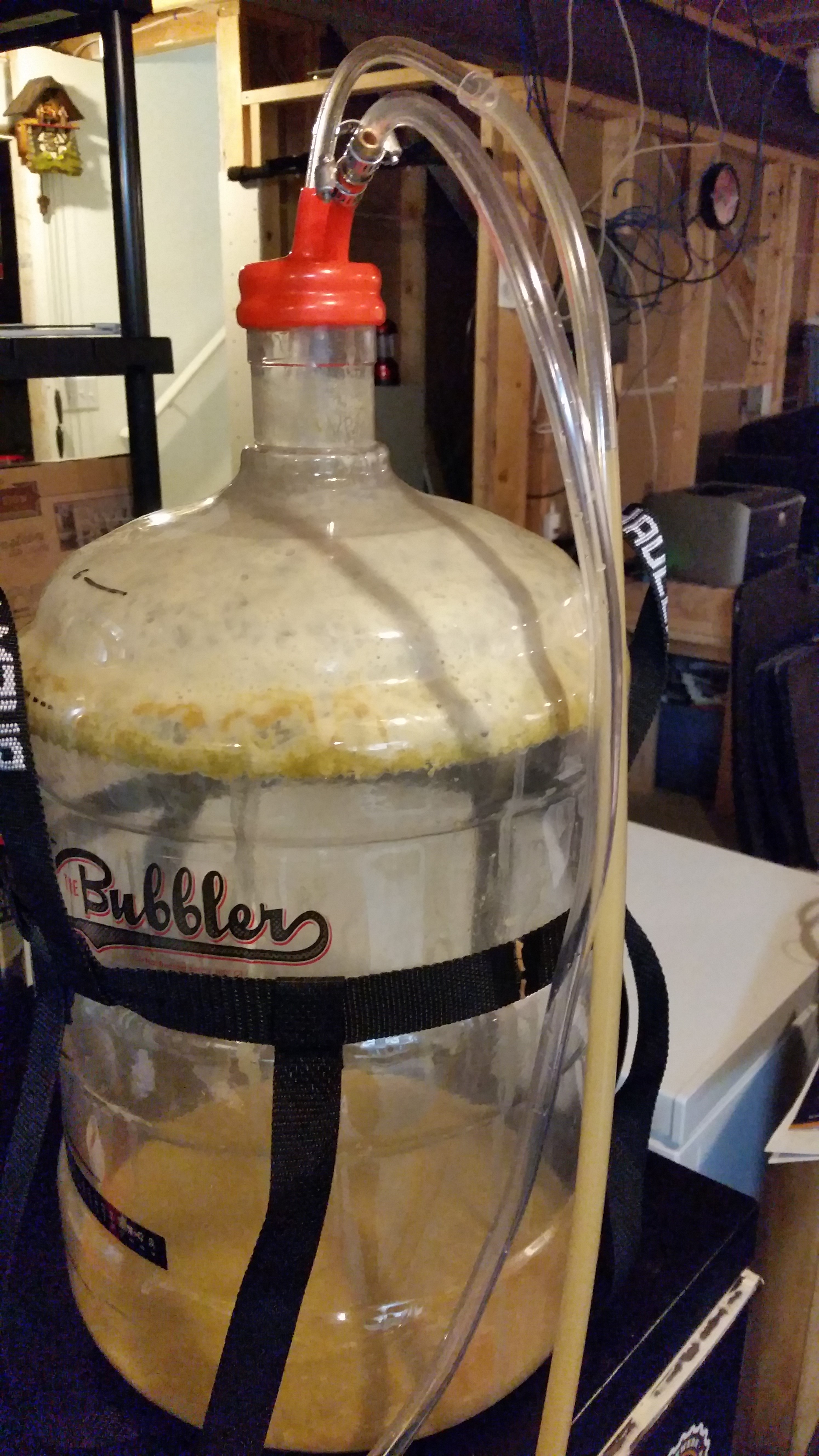
The destination keg should be purged of oxygen (fill it with CO2 and pull the pressure-release valve or otherwize depressurize the keg (mine are pin-lock, so I fill and then use another gas post to depressurize). Additionally, if you’re like me and don’t want to move your CO2 tank, you can use an empty keg as a temporary tank – purge that keg and then pressurize.
If you keg hop, as I did with this, bag the hops and place in the keg before purging.
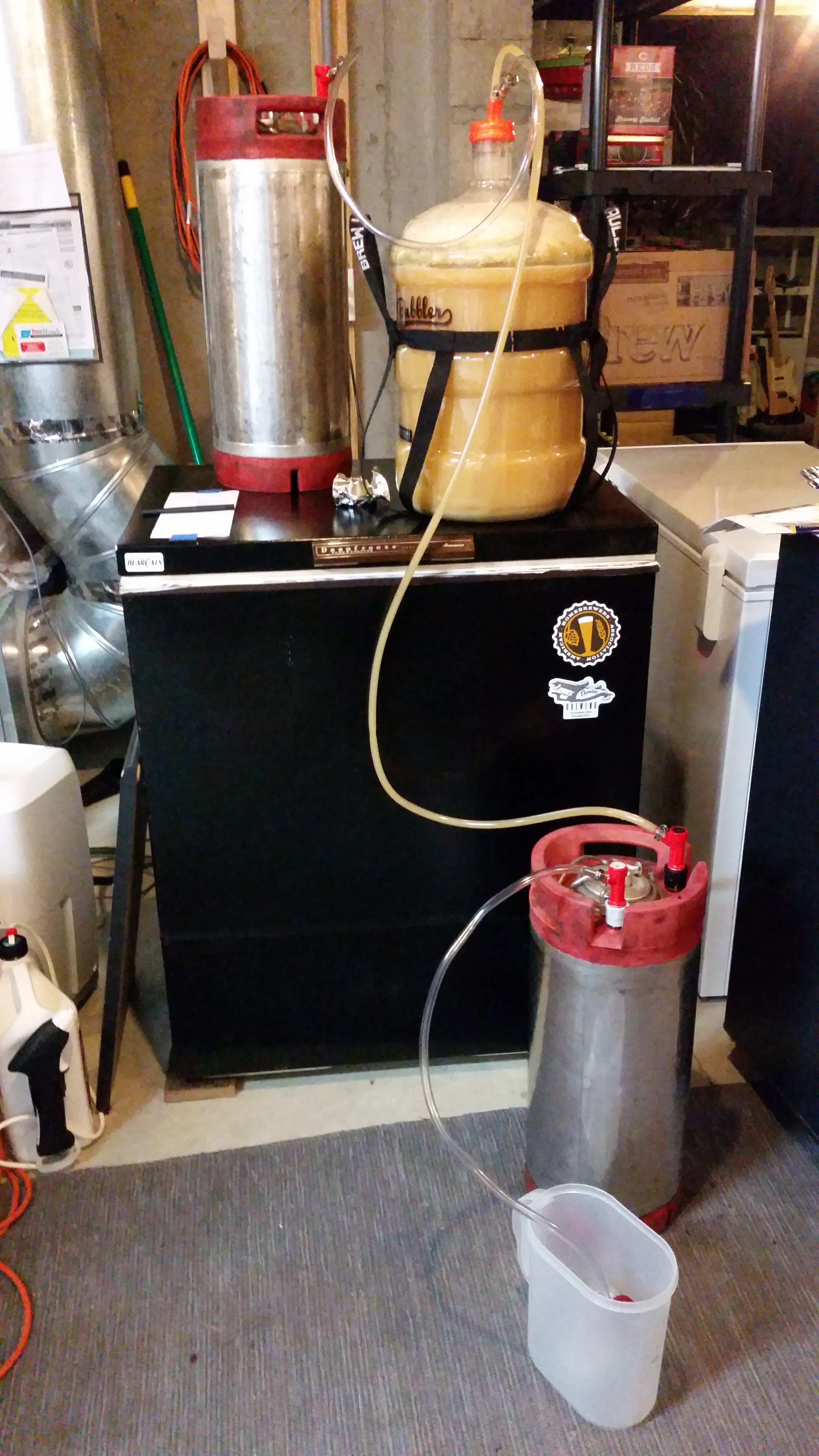
The only time the fermenter has any oxygen exposure is if you have to remove a blow-off or airlock to place the carboy cap. That should be done quick, and prior to doing that, the cap, cane, and line should be sanitized and the posts (on the ends of the lines connected to the carboy cap) should be fully assembled. If you’re using a CO2 tank, connect it and push a little CO2 through it before making the switch.
3: Begin Transfer
Connect the lines in this order:
- Fermenter to Keg
- Keg gas out (into a container of sanitizer, like a blow-off tube).
- HOLD ONTO THE FERMENTER CAP!
- Push (DO NOT CONNECT) the CO2 keg (if using a CO2 tank, use a very low pressure)
- DURING THE TRANSFER, make sure to continually supply CO2 to the fermenter – if it is closed it will start to implode and the siphon will slow.
At some point, the flow will stop. It is unlikely that there will be enough pressure to force beer out through the gas line, what tends to happen is that once the beer gets to it, it’ll stop. If there happens to be enough pressure, you’ll see beer getting into the sanitizer – that’s your signal to stop! Disconnect the keg liquid line (be prepared to wipe up some spillage) and the gas line.
Once that’s done, proceed to carbonate as normal. For this beer, I force-carbonated on about 12 PSI for about a week.
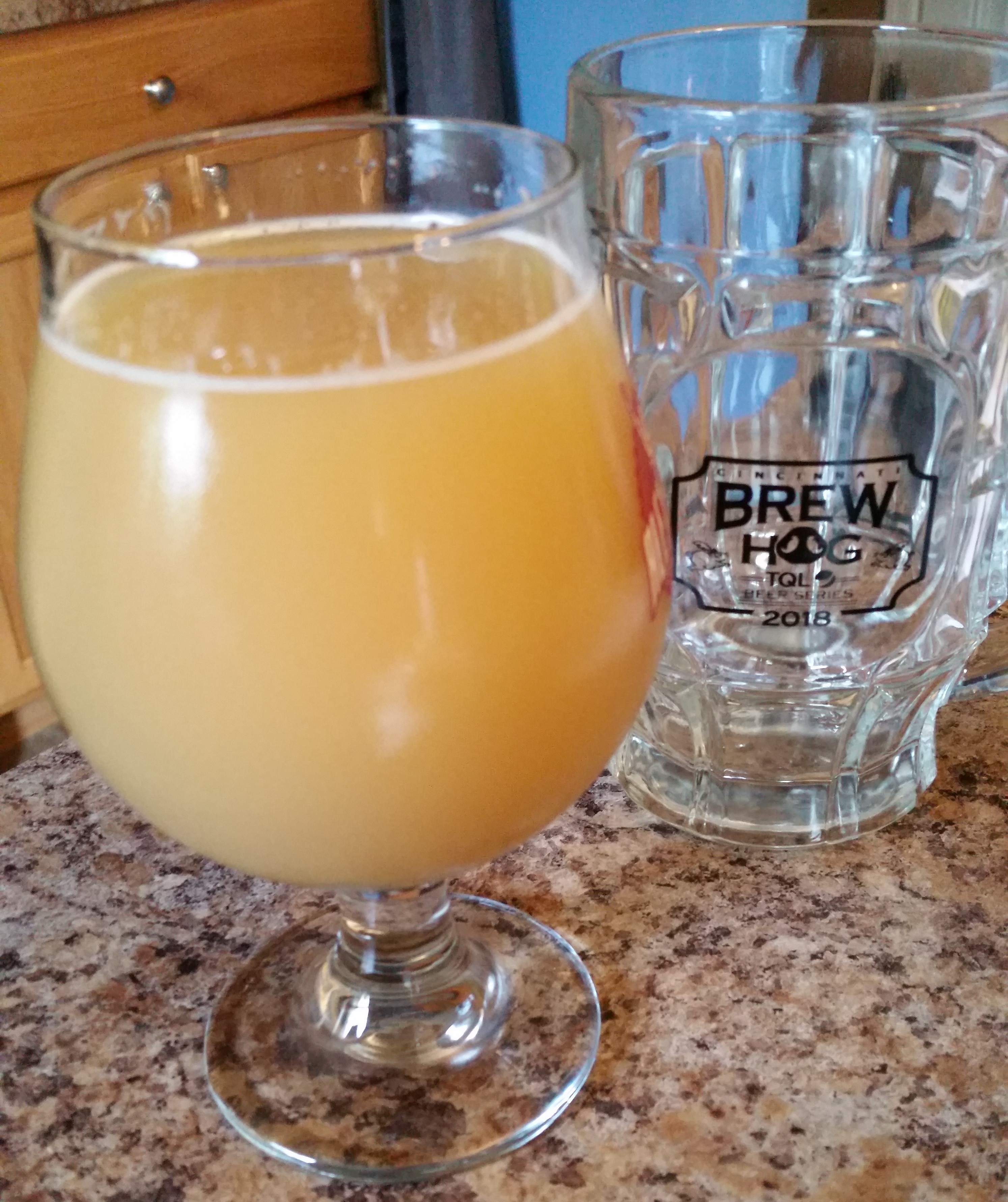
Belgian Wit Brew Day
With the semi-success of the White IPA, I decided to re-use the yeast for a Belgian Wit.
Recipe Details
| Batch Size | Boil Time | IBU | SRM | Est. OG | Est. FG | ABV |
|---|---|---|---|---|---|---|
| 5.5 gal | 60 min | 17.0 IBUs | 4.1 SRM | 1.048 | 1.012 | 4.8 % |
Style Details
| Name | Cat. | OG Range | FG Range | IBU | SRM | Carb | ABV |
|---|---|---|---|---|---|---|---|
| Witbier | 24 A | 1.044 - 1.052 | 1.008 - 1.012 | 8 - 20 | 2 - 4 | 2.6 - 3.4 | 4.5 - 5.5 % |
Fermentables
| Name | Amount | % |
|---|---|---|
| Pale Malt (2 Row) Bel | 5 lbs | 50 |
| Wheat, Flaked | 2 lbs | 20 |
| Wheat Malt, Pale (Weyermann) | 3 lbs | 30 |
Hops
| Name | Amount | Time | Use | Form | Alpha % |
|---|---|---|---|---|---|
| Warrior | 0.25 oz | 60 min | Boil | Pellet | 15 |
| Saaz | 0.5 oz | 15 min | Boil | Pellet | 3 |
Miscs
| Name | Amount | Time | Use | Type |
|---|---|---|---|---|
| Coriander Seed | 0.75 oz | 5 min | Boil | Spice |
| Orange Peel, Bitter | 0.75 oz | 5 min | Boil | Spice |
Yeast
| Name | Lab | Attenuation | Temperature |
|---|---|---|---|
| Belgian Witbier (3944) | Wyeast Labs | 74% | 62°F - 75°F |
Mash
| Step | Temperature | Time |
|---|---|---|
| Mash In | 152°F | 60 min |
Download
| Download this recipe's BeerXML file |
Brew day went without much of a hitch. I was close enough to my expected OG, although my volumes were off (again).
I chilled things down to around 70F and when I noticed the fermenter was cold, I heated it up…
Log
2018-03-24: Brewed
2018-04-05: Kegged
2018-04-21: Judged at Hammerdown Brewcup, 31 avg score
White IPA Brew Day
One of the beers that I’ve purchases as a 6-pack that didn’t stay in my fridge very long was MadTree’s Luna Lux (link includes recipe). For whatever reason, it became my go-to beer for all of six evenings, and that was after having (and thoroughly enjoying) a pint at a local pizza place.
So what does a homebrewer do when a place like MadTree gives you (and everyone!) the recipe? I think most homebrewers would spin it a little. Which I did…
Recipe Details
| Batch Size | Boil Time | IBU | SRM | Est. OG | Est. FG | ABV |
|---|---|---|---|---|---|---|
| 5.5 gal | 60 min | 70.6 IBUs | 6.3 SRM | 1.053 | 1.013 | 5.3 % |
| Actuals | 1.046 | 1.01 | 4.7 % | |||
Style Details
| Name | Cat. | OG Range | FG Range | IBU | SRM | Carb | ABV |
|---|---|---|---|---|---|---|---|
| white ipa | 21 B | 1.056 - 1.065 | 1.01 - 1.016 | 40 - 70 | 5 - 8 | 2.4 - 3 | 5.5 - 7 % |
Fermentables
| Name | Amount | % |
|---|---|---|
| White Wheat Malt | 1.5 lbs | 13.64 |
| Caramel Malt - 20L (Briess) | 8 oz | 4.55 |
| Pale Ale Malt 2-Row (Briess) | 9 lbs | 81.82 |
Hops
| Name | Amount | Time | Use | Form | Alpha % |
|---|---|---|---|---|---|
| Warrior | 0.12 oz | 60 min | Boil | Pellet | 15 |
| Jarrylo | 1 oz | 20 min | Boil | Pellet | 16 |
| Galaxy | 1 oz | 20 min | Aroma | Pellet | 14 |
| Citra | 1 oz | 20 min | Aroma | Pellet | 12 |
| Citra | 1 oz | 7 days | Dry Hop | Pellet | 12 |
| Galaxy | 1 oz | 7 days | Dry Hop | Pellet | 14 |
| Jarrylo | 1 oz | 7 days | Dry Hop | Pellet | 16 |
Miscs
| Name | Amount | Time | Use | Type |
|---|---|---|---|---|
| Lemon Peel | 1.20 oz | 0 min | Boil | Spice |
| Coriander Seed | 0.50 oz | 0 min | Boil | Spice |
Yeast
| Name | Lab | Attenuation | Temperature |
|---|---|---|---|
| Belgian Witbier (3944) | Wyeast Labs | 74% | 62°F - 75°F |
Mash
| Step | Temperature | Time |
|---|---|---|
| Mash In | 152°F | 60 min |
Download
| Download this recipe's BeerXML file |
Brew day was normal with only a few complaints of things I really need to fix – specifically I need to add releases that aren’t hose-barb connectors. And I still hate my plate chiller. This was the first brew day with my new pump, which worked splendidly, although there’s a few details I need to deal with (specifically, I need to have an outlet that I don’t block with kettles, I need to redo one of the fittings, and I need to mount this to a piece of wood or something as a base).
The grain milling needs some fixes, but they’re small. For starters, I need a thicker piece of wood to attach the drill to, and it needs to hold in place with the bucket. And I need to make sure the drill is spinning in the correct direction! Ultimately, I want to move milling outside because of the dust and the fact that I lost a few kernels to the floor.
This fermented for three weeks at 64F, which is the lowest end of the recommendations from Wyeast.
Packaging
I closed transfered from the fermenter to the keg.I’ve tried to do this once before, but this time worked better and with a few small modifications, this will work well.
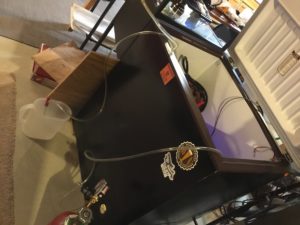
The destination keg is in the keezer, the line coming out and into the pitcher is from the gas in post on the keg.
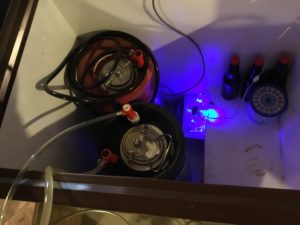
That’s what it looks like in the keezer… And yes, I have a lighted computer case fan circulating air in there.
Log
2018-02-25: Brewed
2018-03-04: 1.016 @ 67F
2018-03-07: 1.010 @ 67F
2018-03-13: 1.008 @ 67F
2018-03-16: 1.008 @ 67F
2018-03-18: Kegged
Tasting Notes
Appearance:hazy pale yellow with a thin lasting white head. Plenty of lacing on the glass.
Aroma: fruity hops with lemon undertone. No esters or phenols.
Flavor: light crackery malt with some orange and lemon flavor. Some spice in the background. Lasting light bitterness, but not overwhelming. No yeast character.
Mouthfeel: light-bodied. Dry and only slightly prickly from the carbonation.
Overall: I’m really enjoying this beer. The flavors really came together. I would have liked a lot more yeast character and a little more hop flavor and aroma, though. I think the next version may have a little bit more dry hopping and will be fermented warmer.
Awards: Won silver in the Hammerdown Brewcup 2018!
Cheers!
Dunkelweisen Brew Day
In Garret Oliver’s The Brewmaster’s Table, Oliver raves about pairing hefeweisens with various German foods – pork in particular, but he also notes that weisens pair well with Mexican food, Indian food, Chinese food, breakfast, seafood, and lamb are all noted (pages 85 to 89). I’ve had one true dunkelweisen – at Hofbrauhaus in Newport, KY, many years ago. According to Untappd, I’ve had a few more – like Shiner Holiday Cheer – that doesn’t seem to fully fit the style (although I like the beer for other reasons). So I had been wanting to brew one.
The Recipe
Recipe Details
| Batch Size | Boil Time | IBU | SRM | Est. OG | Est. FG | ABV |
|---|---|---|---|---|---|---|
| 5 gal | 60 min | 23.2 IBUs | 19.2 SRM | 1.058 | 1.013 | 5.8 % |
| Actuals | 1.046 | 1.013 | 4.3 % | |||
Style Details
| Name | Cat. | OG Range | FG Range | IBU | SRM | Carb | ABV |
|---|---|---|---|---|---|---|---|
| Dunkles Weissbier | 10 B | 1.044 - 1.056 | 1.01 - 1.014 | 10 - 18 | 14 - 23 | 2.9 - 4.1 | 4.3 - 5.6 % |
Fermentables
| Name | Amount | % |
|---|---|---|
| Wheat - Red Malt (Briess) | 5 lbs | 44.44 |
| Caramel Malt - 120L (Briess) | 8 oz | 4.44 |
| Munich 10L (Briess) | 1.5 lbs | 13.33 |
| Swaen©Ale | 4 lbs | 35.56 |
| De-Bittered Black Malt (Dingemans) | 4 oz | 2.22 |
Hops
| Name | Amount | Time | Use | Form | Alpha % |
|---|---|---|---|---|---|
| Magnum | 0.25 oz | 60 min | Boil | Pellet | 14 |
| Tettnang, U.S. | 4 oz | 15 min | Boil | Leaf | 2 |
Miscs
| Name | Amount | Time | Use | Type |
|---|---|---|---|---|
| Lactic Acid | 3.50 ml | 60 min | Mash | Water Agent |
Yeast
| Name | Lab | Attenuation | Temperature |
|---|---|---|---|
| Weihenstephan Weizen (3068) | Wyeast Labs | 75% | 64°F - 75°F |
Mash
| Step | Temperature | Time |
|---|---|---|
| Mash In | 152°F | 60 min |
Download
| Download this recipe's BeerXML file |
The Brewday
Fermentation
This fermented in my basement around 64-68F. My initial taste, around a week after fermentation, it had a subtle banana ester and the floral flavor of a Märzen. Not bad!
One thing to consider when using Wyeast 3068 (the Weinenstephan strain) is you MUST use a blowoff! I had a decent amount of headspace and it still required a blowoff tube.
Log
2017-12-17: Brew day. Mash efficiency: 71%, Brewhouse efficiency: 63.2%
2017-12-24: SG at 1.012
2017-12-27: SG at 1.010
